Medal of Honor
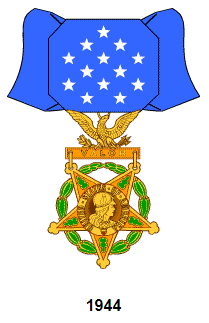
DESCRIPTION: A gold five pointed star, each point tipped with trefoils, 1 ½ inches wide, surrounded by a green laurel wreath and suspended from a gold bar inscribed "VALOR", surmounted by an eagle. In the center of the star, Minerva’s head surrounded by the words "UNITED STATES OF AMERICA." On each ray of the star is a green oak leaf. On the reverse is a bar engraved "THE CONGRESS TO" with a space for engraving the name of the recipient.

DESCRIPTION: The medal is suspended by a neck ribbon, 1 3/8 inches wide, Bluebird 67117. A shield of the same color ribbon with thirteen White (67101) stars, arranged in the form of three chevrons is above the medal. The service ribbon is 1/38 inches wide with five White stars in the form of a "M".
CRITERIA The Medal of Honor is awarded by the President, in the name of Congress, to a person who, while a member of the Army, distinguishes himself or herself conspicuously by gallantry and intrepidity at the risk of his or her life above and beyond the call of duty while engaged in action against an enemy of the United States; while engaged in military operations involving conflict with an opposing foreign force; or while serving with friendly foreign forces engaged in an armed conflict against an opposing armed force in which the United States is not a belligerent party. The deed performed must have been one of personal bravery or self-sacrifice so conspicuous as to clearly distinguish the individual above his or her comrades and must have involved risk of life. Incontestable proof of the performance of the service will be exacted and each recommendation for the award of this decoration will be considered on the standard of extraordinary merit..
BACKGROUND: a. General George Washington had created the Badge of Military Merit on 7 August 1792 but it had fallen into disuse after the Revolutionary War. Decorations, as such, were still too closely related to European royalty to be of concern to the American people. However, the fierce fighting and deeds of valor during the Civil War brought into focus the realization that such valor must be recognized. Legislation was introduced in the Senate on 17 February 1862, which authorized the medal for the Army and followed the pattern of a similar award approved for Naval personnel in December 1861. The Resolution provided that: "The President of the United States be, and he is hereby, authorized to cause two thousand "medals of honor" to be prepared with suitable emblematic devices, and to direct that the same be presented, in the name of Congress, to such noncommissioned officers and privates as shall most distinguish themselves by their gallantry in action, and other soldier-like qualities during the present insurrection, and the sum of ten thousand dollars be, and the same is hereby appropriated out of any money in the Treasury not otherwise appropriated, for the purpose of carrying this resolution into effect."
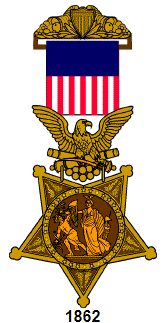
b. The original design for the Army was created by Christian Schussel and engraved by Anthony C. Pacquot. The pendant was identical to the design approved by the Navy, with the exception of the suspension and clasp. It consisted of a five-pointed star, tipped with trefoils containing a crown of laurel and oak. In the middle, a band of 34 stars represented the number of States in 1862. Minerva, personifying the United States, stands with a left hand resting on fasces and right hand holding a shield blazoned with the United States arms. She repulses Discord, represented by snakes. The pendant was suspended by a trophy of crossed cannons, balls, sword and an American eagle. The clasp was two cornucopias and the arms of the United States.
c. The initial law was amended by an Act of Congress on 3 March 1863 to extend its provisions to include officers.
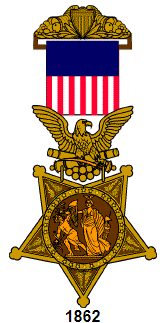
d. In 1896, misuse of the medal led to a change in the design of the ribbon because the original had been imitated by nonmilitary organizations. This change was authorized by Joint Resolution of Congress, Fifty-Fourth Congress, Sess. I, 2 May 1896. At this time a bowknot (rosette) was adopted to be worn in lieu of the medal. The ribbon and bowknot (rosette), established and prescribed by the President, was promulgated in War Department Orders dated 10 November 1896.
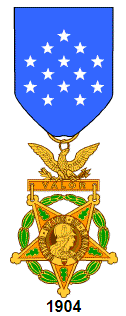
e. On 23 April 1904, Congress authorized a new design of the medal. The design adopted at that time was designed by Major General George L. Gillespie and is the one currently in use. The medal was worn either suspended from the neck or pinned over the left breast in precedence to other military decorations.
f. The present neck ribbon was adopted in 1944. It is worn outside the shirt collar and inside the coat, hanging above all other decorations.
g. Special entitlements for recipients of the Medal of Honor include:
(1) Each Medal of Honor awardee may have his name entered on the Medal of Honor Roll (38 USC 560). Each person whose name is placed on the Medal of Honor Roll is certified to the Department of Veterans Affairs as being entitled to receive the special pension of $400 per month.
(2) Enlisted recipients of the Medal of Honor are entitled to a supplemental uniform allowance.
(3) Special entitlements to air transportation under the provisions of DOD Regulation 4515.13-R.
(4) Identification card, commissary and exchange privileges for Medal of Honor recipients and their eligible dependents.
(5) Children of recipients are eligible for admission to the U.S. Service Academies without regard to the quota requirements.
(6) Ten percent increase in retired pay under Title 10, USC 3991, subject to the 75% limit on total retired pay.
Distinguished Service Cross
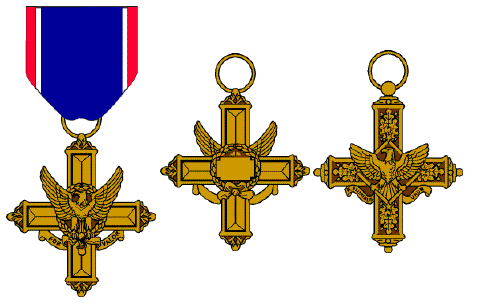
DESCRIPTION: A cross of bronze, 2 inches in height and 1 13/16 inches in width with an eagle on the center and a scroll below the eagle bearing the inscription "FOR VALOR". On the reverse side, the center of the cross is circled by a wreath with a space for engraving the name of the recipient.
RIBBON: The ribbon is 1 3/8 inches wide and consists of the following stripes: 1/8 inch Old Glory Red 67156; 1/16 inch White 67101; 1 inch Imperial Blue 67175; 1 1/16 inch White; and 1/8 inch Old Glory Red.
CRITERIA::The Distinguished Service Cross is awarded to a person who, while serving in any capacity with the Army, distinguishes himself or herself by extraordinary heroism not justifying the award of a Medal of Honor; while engaged in an action against an enemy of the United States; while engaged in military operations involving conflict with an opposing/foreign force; or while serving with friendly foreign forces engaged in an armed conflict against an opposing Armed Force in which the United States is not a belligerent party. The act or acts of heroism must have been so notable and have involved risk of life so extraordinary as to set the individual apart from his or her comrades.
COMPONENTS: The following are authorized components of the Distinguished Service Cross:
a. Decoration (regular size): MIL-D-3943/4. NSN 8455-00-269-5745 for decoration set. NSN 8455-00-246-3827 for individual replacement medal.
b. Decoration (miniature size): MIL-D-3943/4. NSN 8455-00-996-50007.
c. Ribbon: MIL-R-11589/50. NSN 8455-00-252-9919.
d. Lapel Button (metal replica of ribbon bar): MIL-L-11484/1. NSN 8455-00-253-0808.
BACKGROUND: a. The Distinguished Service Cross was established by President Woodrow Wilson on January 2, 1918. General Pershing, Commander-in-Chief of the Expeditionary Forces in France, had recommended that recognition other than the Medal of Honor, be authorized for the Armed Forces of the United States for service rendered, in like manner, to that awarded by the European Armies. The request for establishment of the medal was forwarded from the Secretary of War to the President in a letter dated December 28, 1917. The Act of Congress establishing this award (193-65th Congress) dated July 9, 1918 is contained in Title 10 United States Code (USC) 3742. The establishment of the Distinguished Service Cross was promulgated in War Department General Order No. 6, dated January 12, 1918.
b. The first design of the Distinguished Service Cross was cast and manufactured by the United States Mint at Philadelphia. The die was cast from the approved design prepared by Lieutenant Aymar E. Embry, Engineers Officer Reserve Corps. Upon examination of the first medals struck at the Mint, it was considered advisable to make certain minor changes to add to the beauty and the attractiveness of the medal. Due to the importance of the time element involved in furnishing the decorations to General Pershing, one hundred of the medals were struck from the original design and numbered 1 to 100. These medals were furnished with the provision that these crosses be replaced when the supply of the second design was accomplished which would also be numbered 1 to 100.
c. Title 10, USC 3991, provides for a 10% increase in retired pay for enlisted personnel who have retired with more than 20 years of service if they have been awarded the Distinguished Service Cross.
d. Order of precedence and wear of decorations is contained in Army Regulation (AR) 670-1. Policy for awards, approving authority, supply, and issue of decorations is contained in AR 600-8-22.
Distinguished Service Medal
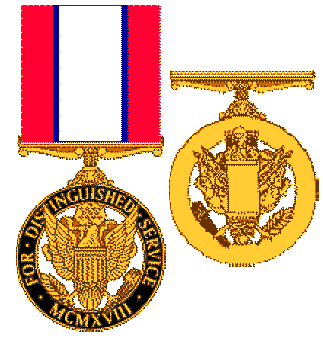
DESCRIPTION: The Coat of Arms of the United States in Gold surrounded by a circle of Dark Blue enamel, 1 ½ inches in diameter, bearing the inscription "FOR DISTINGUISHED SERVICE MCMXVIII". On the reverse is a scroll for the name of the recipient (which is to be engraved) upon a trophy of flags and weapons. The medal is suspended by a bar attached to the ribbon.
RIBBON: The ribbon is 1 3/8 inches wide and consists of the following stripes: 5/16 inch Scarlet 67111; 1/16 inch Ultramarine Blue 67118; 5/8 inch White 67101; 1/16 inch Ultramarine Blue; and 5/16 inch Scarlet.
CRITERIA: he Distinguished Service Medal is awarded to any person who, while serving in any capacity with the United States Army, has distinguished himself or herself by exceptionally meritorious service to the Government in a duty of great responsibility. The performance must be such as to merit recognition for service which is clearly exceptional. Exceptional performance of normal duty will not alone justify an award of this decoration.
a. For service not related to actual war, the term "duty of a great responsibility" applies to a narrower range of positions, than in time of war, and requires evidence of conspicuously significant achievement. However, justification of the award may accrue by virtue of exceptionally meritorious service in a succession of high positions of great importance.
b. Awards may be made to persons other than members of the Armed Forces of the United States for wartime services only, and then only under exceptional circumstances, with the express approval of the President in each case.
COMPONENTS:The following are authorized components of the Distinguished Service Medal and applicable specifications:
a. Decoration (regular size): MIL-D-3943/7. NSN for decoration set: 8455-00-444-0007. NSN for replacement medal is 8455-00-246-3830.
b. Decoration (miniature size): MIL-D-3943/7. NSN 8455-00-996-5008.
c. Ribbon: MIL-R-11589/52. NSN 8455-00-252-9922.
d. Lapel Button (metal replica of ribbon bar): MIL-L-11484/4. NSN 8455-00-253-0809.
BACKGROUND: The following are authorized components of the Distinguished Service Medal and applicable specifications:
a. Decoration (regular size): MIL-D-3943/7. NSN for decoration set: 8455-00-444-0007. NSN for replacement medal is 8455-00-246-3830.
b. Decoration (miniature size): MIL-D-3943/7. NSN 8455-00-996-5008.
c. Ribbon: MIL-R-11589/52. NSN 8455-00-252-9922.
d. Lapel Button (metal replica of ribbon bar): MIL-L-11484/4. NSN 8455-00-253-0809.
Silver Star
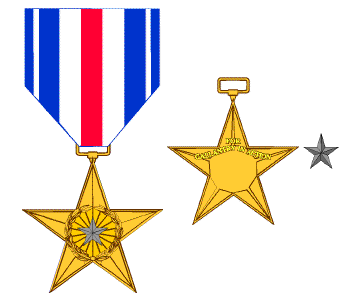
DESCRIPTION: A Gold star, 1 ½ inches in circumscribing diameter with a laurel wreath encircling rays from the center and a 3/16 inch diameter silver star superimposed in the center. The pendant is suspended from a rectangular shaped metal loop with rounded corners. The reverse has the inscription "FOR GALLANTRY IN ACTION".
RIBBON: The ribbon is 1 3/8 inches wide and consists of the following stripes: 3/32 inch Ultramarine Blue 67118; 3/64 inch White 67101; 7/32 inch Ultramarine Blue; 7/32 inch White; 7/32 inch Old Glory Red 67156 (center stripe); 7/32 inch White; 7/32 inch Ultramarine Blue; 3/64 inch White; and 3/32 inch Ultramarine Blue.
CRITERIA:
The Silver Star is awarded to a person who, while serving in any capacity with the U.S. Army, is cited for gallantry in action against an enemy of the United States while engaged in military operations involving conflict with an opposing foreign force, or while serving with friendly foreign forces engaged in armed conflict against an opposing armed force in which the United States is not a belligerent party. The required gallantry, while of a lesser degree than that required for award of the Distinguished Service Cross, must nevertheless have been performed with marked distinction. Soldiers who received a citation for gallantry in action during World War I may apply to have the citation converted to the Silver Star Medal.
COMPONENTS.
The following are authorized components of the Silver Star Medal:
a. Decoration (regular size): MIL-D-3943/11. NSN for decoration set: 8455-00-269-5758. Individual medal: 8455-00-246-3834.
b. Decoration (miniature size): MIL-D-3943/11. NSN 8455-00-996-5013.
c. Ribbon: MIL-R-11589/136. NSN 8455-00-252-9953.
d. Lapel Button: MIL-L-11484/9. NSN 8455-00-253-0819.
BACKGROUND.
a. The Citation Star was established as a result of an Act of Congress on July 9, 1918 (65th Congress, Sess II, Chapter 143, page 873) and was promulgated in War Department Bulletin No. 43 dated 1918. It was retroactive to include those cited for gallantry in action in previous campaigns back to the Spanish-American War. Per letter from General Jervey, Office of the Chief of Staff, dated February 26, 1926, is quoted in part: The Secretary of War directs as follows - The following is the amended version of paragraph 187 of Army Regulation: "No more than one Medal of Honor or one Distinguished Service Cross or one Distinguished Service Medal shall be issued to any one person, but for each succeeding or act sufficient to justify the award of a Medal of Honor or Distinguished Service Cross or Distinguished Service Medal, respectively, a bronze oak leaf cluster, shall be issued in lieu thereof; and for each citation of an officer or enlisted man for gallantry in action, published in orders from headquarters of a force commanded by a general officer, not warranting the issue of a Medal of Honor, Distinguished Service Cross or Distinguished Service Medal, he shall wear a silver star, 3/16 inch in diameter, as prescribed in Uniform Regulations." Army Regulation 600-40, paragraph 48, September 27, 1921, specified that the Citation Star would be worn above the clasp, on the ribbon of the service medal for the campaign for service in which the citations were given.
b. On July 19, 1932, the Secretary of War approved the Silver Star medal to replace the Citation Star. This design placed the Citation Star on a bronze pendant suspended from the ribbon design. The star was no longer attached to a service or campaign ribbon.
c. Authorization for the Silver Star was placed into law by an Act of Congress for the Navy on August 7, 1942 and an Act of Congress for the Army on December 15, 1942. The primary reason for congressional authorization was the desire to award the medal to civilians as well as the Army. The current statutory authorization for the Silver Star Medal is Title 10, United States Code, Section 3746.
d. Order of precedence and wear of decorations is contained in Army Regulation 670-1. Policy for awards, approving authority, supply, and issue of decorations is contained in Army Regulation 600-8-22.
Legion of Merit
DESCRIPTION: The degrees of the Legion of Merit are as depicted below with description and components for each:
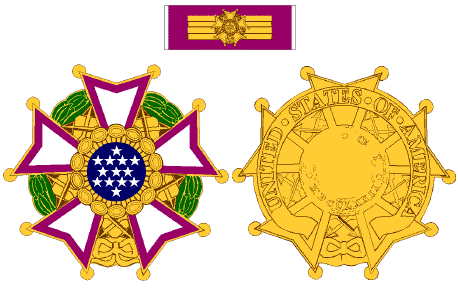
Chief Commander:
(1) Description: On a wreath of Green laurel joined at the bottom by a Gold bow-knot (rosette), a domed five-pointed White star bordered Crimson, points reversed with v-shaped extremities tipped with a Gold ball. In the center, a Blue disk encircled by Gold clouds, with 13 White stars arranged in the pattern that appears on the United States Coat of Arms. Between each point, within the wreath are crossed arrows pointing outwards. The overall width is 2 15/16 inches. The words "UNITED STATES OF AMERICA" are engraved in the center of the reverse. A miniature of the decoration in Gold on a horizontal Gold bar is worn on the service ribbon.
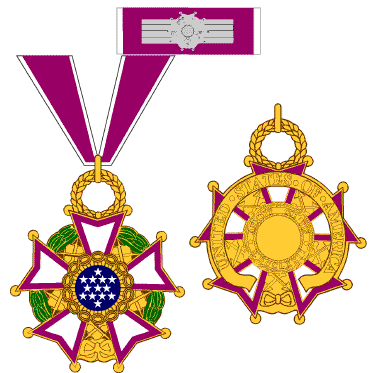
Commander:
(1) Description: On a wreath of Green laurel joined at the bottom by a Gold bow-knot (rosette), a five-pointed White star bordered Crimson, points reversed with v-shaped extremities tipped with a Gold ball. In the center, a Blue disk encircled by Gold clouds, with 13 White stars arranged in the pattern that appears on the United States Coat of Arms. Between each star point, within the wreath are crossed arrows pointing outwards. The overall width is 2 1/4 inches. A Gold laurel wreath in the v-shaped angle at the top connects an oval suspension ring to the neck ribbon that is 1 15/16 inches in width. The reverse of the five-pointed star is enameled in White, and the border is Crimson. In the center, a disk for engraving the name of the recipient surrounded by the words "ANNUIT COEPTIS MDCCLXXXII." An outer scroll contains the words "UNITED STATES OF AMERICA." The service ribbon is the same as the ribbon for the degree of Commander, except the ribbon attachment is Silver.
(2) Components: The decoration set for degree of Commander consists of the decoration, service ribbon and lapel button and is NSN 8455-00-269-5753. Individual components are the decoration, MIL-D-3943/14, NSN 8455-00-246-3819; the service ribbon, MIL-R-11589/80, NSN 8455-00-252-9928; and the lapel button, MIL-L-11484/10-2, NSN 8455-00-253-0814. The neck ribbon for the degree of Commander is 1 15/16 inches wide and consists of the following stripes: 1/16 inch White 67101; center 1 13/16 inches Crimson 67112; and 1/16 inch White.
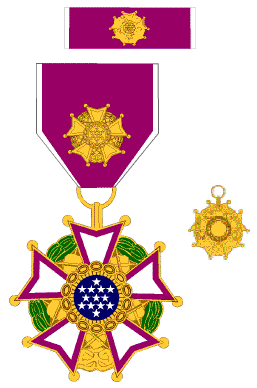
Officer:
(1) Description: The design is the same as the degree of Commander except overall width is 1 7/8 inches and the pendant has a suspension ring instead of the wreath for attaching the ribbon. A Gold replica of the medal, 3/4 inch wide, is centered on the suspension ribbon.
(2) Components. The decoration set for degree of Officer consists of the decoration, service ribbon and lapel button and is NSN 8455-00-269-5754. Individual components are the regular size decoration, MIL-D-3943/13, NSN 8455-00-246-3823; the service ribbon, MIL-R-11589/80, NSN 8455-00-252-9936; and the lapel button, MIL-L-11484/10-3, NSN 8455-00-257-4307. The miniature decoration, MIL-D-3943/13, is not part of the set but is stocked separately, NSN 8455-00-996-5010.
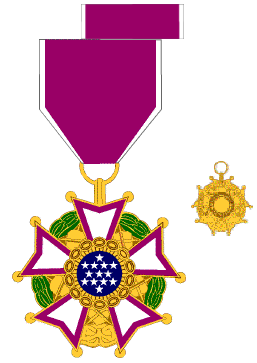
LEGIONNAIRE/LEGION OF MERIT:
(1) Description: The design is the same as the degree of Officer, except the suspension ribbon does not have the medal replica.
(2) COMPONENTS: The decoration set for degree of Legionnaire and the Legion of Merit issued to U.S. personnel consists of the decoration, service ribbon and lapel button and is NSN 8455-00-262-3469. Individual components are the regular size decoration, MIL-D-3943/13, NSN 8455-00-246-3832; the service ribbon, MIL-R-11589/80, NSN 8455-00-252-9932; and the lapel button, MIL-L-11484/10-4, NSN 8455-00-257-4306. The miniature decoration, MIL-D-3943/13, is not part of the set but is stocked separately, NSN 8455-00-996-5009.
RIBBON: The ribbon for the decorations is 1 3/8 inches wide and consists of the following stripes: 1/16 inch White 67101; center 1 1/4 inches Crimson 67112; and 1/16 inch White.
CRITERIA:
a. The degrees of Chief Commander, Commander, Officer, and Legionnaire are awarded only to members of armed forces of foreign nations under the criteria outlined in Army Regulation 672-7 and is based on the relative rank or position of the recipient as follows:
(1) Chief Commander - Chief of State or Head of Government.
(2) Commander - Equivalent of an U.S. military Chief of Staff or higher position but not to Chief of State.
(3) Officer - General of Flag Officer below the equivalent of a U.S. military Chief of Staff; Colonel or equivalent rank for service in assignments equivalent to those normally held by a General or Flag Officer in U.S. military service; or Military Attaches.
(4) Legionnaire - All recipients not included above.
b. The Legion of Merit is awarded to all members of the Armed Forces of the United States without reference to degree for exceptionally meritorious conduct in the performance of outstanding services and achievements. The performance must have been such as to merit recognition of key individuals for service rendered in a clearly exceptional manner. Performance of duties normal to the grade, branch, specialty or assignment, and experience of an individual is not an adequate basis for this award. For service not related to actual war the term "key individual" applies to a narrower range of positions than in time of war and requires evidence of significant achievement. In peacetime, service should be in the nature of a special requirement or of an extremely difficult duty performed in an unprecedented and clearly exceptional manner. However, justification of the award may accrue by virtue of exceptionally meritorious service in a succession of important positions.
BACKGROUND:
a. Although recommendations for creation of a Meritorious Service Medal were initiated as early as September 1937, no formal action was taken toward approval. In a letter to the Quartermaster General (QMG) dated 24 December 1941, The Adjutant General formally requested action be initiated to create a Meritorious Service Medal and provide designs in the event the decoration was established. Proposed designs prepared by Bailey, Banks, and Biddle and the Office of the Quartermaster General were provided to Assistant Chief of Staff G1 (Colonel Heard) by the QMG on 5 January 1942. The Assistant Chief of Staff G1 (BG Hilldring) in a response to the QMG on 3 April 1942, indicated the Secretary of War approved the design recommended by the QMG and directed action be taken to assure the design of the Legion of Merit (change of name) be ready for issue immediately after legislation authorizing it was enacted into law.
b. An Act of Congress (Public Law 671 - 77th Congress, Chapter 508, 2d Session) on 20 July 1942, established the Legion of Merit and provided that the medal "shall have suitable appurtenances and devices and not more than four degrees, and which the President, under such rules and regulations as he shall prescribe, may award to (a) personnel of the Armed Forces of the United States and of the Government of the Commonwealth Philippines and (b) personnel of the armed forces of friendly foreign nations who, since the proclamation of an emergency by the President on 8 September 1939, shall have distinguished themselves by exceptionally meritorious conduct in the performance of outstanding services". The medal was announced in War Department Bulletin No. 40 dated 5 August 1942. Executive Order 9260, dated 29 October 1942, by President Roosevelt, established the rules for the Legion of Merit and required the President's approval for award. However, in 1943, at the request of General George C. Marshall, approval authority for U.S. personnel was delegated to the War Department. Executive Order 10600, dated 15 March 1955, by President Eisenhower, revised approval authority. Current provisions are contained in Title 10, United States Code 1121.
c. The reverse of the medal has the motto taken from the Great Seal of the United States "ANNUIT COEPTIS" (He [God] Has Favored Our Undertakings) and the date "MDCCLXXXII" (1782) which is the date of America's first decoration, the Badge of Military Merit, now known as the Purple Heart. The ribbon design also follows the pattern of the Purple Heart ribbon.
d. The Legion of Merit was the first American decoration awarded to citizens of other nations. Awardees included:
(1) Chief Commander - China's Generalissimo Chiang Kaishek was a first recipient.
(2) Commander - Brazil's Brigadier General Amaro Soares Bittencourt was first to receive this or any of the degrees.
(3) Officer - first to receive the Officer degree were Colonel Johanes K. Meijer of the Royal Netherlands Army, Major Herbert J. Thompson of the British Army, and Major Stephan M. Dobrowalski of the Polish Army.
(4) Legionnaire/Legion of Merit - First award to Lieutenant Anna A. Bernatitus, heroic Navy Nurse who served at Bataan and Corregidor.
(5) At the beginning of the North African Campaign, General Lyman L. Lemnitzer accompanied General Mark Clark by submarine to North Africa. Upon arrival, about 60 officers were awarded the Legion of Merit and were among the first awarded the medal. By some misunderstanding as to the rules governing the awards, these 60 American Officers were awarded the degree of Officer. According to General Lemnitzer, President Roosevelt was annoyed, however, he did not rescind the awards. Accordingly, these were the only American Officers awarded the Legion of Merit with a degree.
e. Order of precedence and wear of decorations is contained in Army Regulation 670-1. Policy for awards, approving authority, supply, and issue of decorations is contained in Army Regulation 600-8-22.
Distinguished Flying Cross
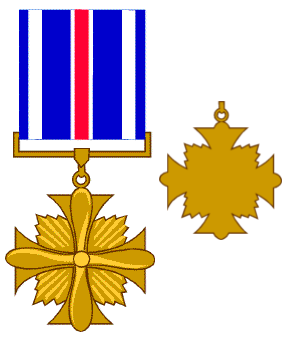
DESCRIPTION:
A Bronze cross patee on which is superimposed a four-bladed propeller, 1 11/16 inches in width. Five rays extended from the reentrant angles, forming a one-inch square. The medal is suspended from a rectangular shaped bar.
RIBBON:
The ribbon is 1 3/8 inches wide and consists of the following stripes: 3/32 inch Ultramarine Blue 67118; 9/64 inch White 67101; 11/32 inch Ultramarine Blue 67118; 3/64 inch White 67101; center stripe 3/32 inch Old Glory Red 67156; 3/64 inch White 67101; 11/32 inch Ultramarine Blue 67118; 9/64 inch White 67101; 3/32 inch Ultramarine Blue 67118.
CRITERIA: The Distinguished Flying Cross is awarded to any person who, while serving in any capacity with the Armed Forces of the United States, distinguishes himself by heroism or extraordinary achievement while participating in aerial flight. The performance of the act of heroism must be evidenced by voluntary action above and beyond the call of duty. The extraordinary achievement must have resulted in an accomplishment so exceptional and outstanding as to clearly set the individual apart from his comrades or from other persons in similar circumstances. Awards will be made only to recognize single acts of heroism or extraordinary achievement and will not be made in recognition of sustained operational activities against an armed enemy.
COMPONENTS:
The following are authorized components of the Distinguished Flying Cross:
a. Decoration (regular size): MIL-D-3943/15. NSN 8455-00-269-5748 for decoration set. NSN 8455-00-246-3826 for individual replacement medal.
b. Decoration (miniature size): MIL-D-3943/15. NSN 8455-00-996-5006.
c. Ribbon: MIL-R-11589/47. NSN 8455-00-252-9967.
d. Lapel Button (metal replica of ribbon): MIL-L-11484/11. NSN 8455-00-253-0807.
BACKGROUND:
a. The Distinguished Flying Cross was established in the Air Corps Act (Act of Congress, 2 July 1926, Public Law No. 446, 69th Congress). This act provided for award "to any person, while serving in any capacity with the Air Corps of the Army of the United States, including the National Guard and the Organized Reserves, or with the United States Navy, since the 6th day of April 1917, has distinguished, or who, after the approval of this Act, distinguishes himself by heroism or extraordinary achievement while participating in an aerial flight."
b. Various designs from the U.S. Mint, commercial artists, and the Office of the Quartermaster General, were submitted to the Commission of Fine Arts and on 31 May 1927. The Commission approved a design submitted by Mr. Arthur E. Dubois and Miss Elizabeth Will.
c. Initial awards of the Distinguished Flying Cross were made to persons who made record breaking long distance and endurance flights and who set altitude records. The Secretary of War authorized the first Distinguished Flying Cross to Captain Charles A. Lindbergh in a letter dated 31 May 1927. With the support of the Secretary of War, the Wright Brothers retroactively received the Distinguished Flying Cross. This award required a special Act of Congress, since the law precluded award to civilians.
d. The current statutory requirements for award of the Distinguished Flying Cross to Army personnel is contained in Title 10, U.S.C., Section 3749; Section 6245 for Navy personnel; and Section 8749 for Air Force personnel. Enlisted personnel may be entitled to a 10% increase in retired pay under Title 10, U.S.C., Section 3991, when credited with heroism equivalent to that required for the award of the Distinguished Service Cross.
e. Order of precedence and wear of decorations is contained in Army Regulation 670-1. Policy for awards, approving authority, supply, and issue of decorations is contained in Army Regulation 600-8-22.
Soldier's Medal
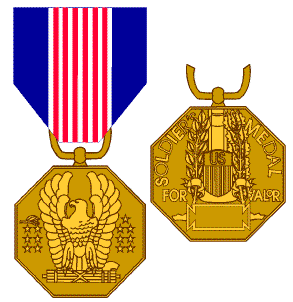
DESCRIPTION: On a 1 3/8 inch wide Bronze octagon an eagle displayed, standing on a fasces, between two groups of stars of six and seven, above the group of six a spray of leaves. On the reverse is a shield paly of 13 pieces, on the chief the letters "US", supported by sprays of laurel and oak, around the upper edge the inscription "SOLDIER’S MEDAL" and across the face the words "FOR VALOR." In the base is a panel for the name of the recipient to be engraved. The medal is suspended from the ribbon by a rectangular-shaped metal loop with corners rounded..
RIBBON: The ribbon is 1 3/8 inches wide and consists of the following stripes: 3/8 inch Ultramarine Blue 67118 on each side and the center containing 13 White and Red stripes of equal width (7 White 67101 and 6 Old Glory Red 67156).
CRITERIA: The Soldier’s Medal is awarded to any person of the Armed Forces of the United States, or of a friendly foreign nation who while serving in any capacity with the Army of the United States, distinguished him/herself by heroism not involving actual conflict with an enemy. The same degree of heroism is required as for the award of the Distinguished Flying Cross. The performance must have involved personal hazard or danger and the voluntary risk of life under conditions not involving conflict with an armed enemy. Awards will not be made solely on the basis of having saved a life.
COMPONENTS:The following are authorized components of the Soldier’s Medal.
a. Decoration (regular size): MIL-D-3943/16. NSN 8455-00-269-5759 for decoration set. NSN 8455-00-246-3835 for individual medal.
b. Decoration (miniature size): MIL-D-3943/16. NSN 8455-00-996-5014.
c. Ribbon: MIL-R-11589/137. NSN 8455-00-252-9956.
d. Lapel Button: MIL-L-11484/12. NSN 8455-00-253-0820.
BACKGROUND:
a. A need to recognize acts of heroism in 1922 resulted in the War Department issuing War Department orders for acts of bravery during peacetime. This led to an Act of Congress (Public Law 446-69th Congress, 2 July 1926 (44 Stat. 780)) which established the Soldier’s Medal for acts of heroism not involving actual conflict with an enemy. The Secretary of War directed that the Quartermaster General prepare and submit appropriate designs of the Soldier’s Medal per letter signed by The Adjutant General dated 11 August 1926.
b. The Secretary of War requested assistance in preparing a design from the Secretary of Treasury by letter dated 18 January 1927. In a response to the Secretary of War by letter dated 22 January 1927, the Secretary of Treasury indicated that the Director of the Mint had been instructed to request the Engraver of the Mint at Philadelphia to submit designs and model. A proposed design was completed and forwarded from the Philadelphia Mint on 22 June 1927 and forwarded to the Commission of Fine Arts for comments. The Commission of Fine Arts in a letter to the Secretary of War dated 27 February 1928 stated.. "It would be a very serious disappointment to this Commission, after all its struggles to obtain good medals, to have to rely on work of this character. One of the fundamental objections to the designs submitted is a lack of that simplicity which should characterize all medals of the highest class. The designs and casts are disapproved and returned". Subsequent designs were submitted and rejected by the Commission in November 1929. The Quartermaster General forwarded a letter to Mr. Gaetano Cecere, New York, NY on 20 January 1930, requesting a design and indicating the War Department would pay not more than $1500.00 for an approved design and cast. Mr. Cecere provided a proposed design in April 1930 that was approved by the Commission on 5 May 1930.
c. Title 10, United States Code (USC), Section 3750 contains current statutory requirements for the Soldier’s Medal. Enlisted personnel may be entitled to an increase in retired pay under Title 10, USC 3991 when credited with heroism equivalent to that required for the award of the Distinguished Service Cross.
d. Order of precedence and wear of decorations is contained in Army Regulation 670-1. Policy for awards, approving authority, supply, and issue of decorations is contained in Army Regulation 600-8-22.
Bronze Star Medal
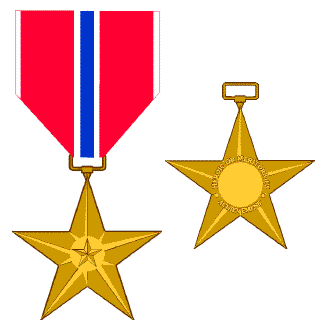
DESCRIPTION:A Bronze star 1 ½ inches in circumscribing diameter. In the center thereof is a 3/16-inch diameter superimposed bronze star, the center line of all rays of both stars coinciding. The reverse has the inscription "HEROIC OR MERITORIOUS ACHIEVEMENT" and a space for the name of the recipient to be engraved. The star is suspended from the ribbon by a rectangular shaped metal loop with the corners rounded.
RIBBON: The ribbon is 1 3/8 inches wide and consists of the following stripes: 1/32 inch White 67101; 9/16 inch Scarlet 67111; 1/32 inch White; center stripe 1/8 inch Ultramarine Blue 67118; 1/32 inch White; 9/16 inch Scarlet; and 1/32 inch White.
CRITERIA: a. The Bronze Star Medal is awarded to any person who, while serving in any capacity in or with the military of the United States after 6 December 1941, distinguished himself or herself by heroic or meritorious achievement or service, not involving participation in aerial flight, while engaged in an action against an enemy of the United States; while engaged in military operations involving conflict with an opposing foreign force; or while serving with friendly foreign forces engaged in an armed conflict against an opposing armed force in which the United States is not a belligerent party.
b. Awards may be made for acts of heroism, performed under circumstances described above, which are of lesser degree than required for the award of the Silver Star.
c. Awards may be made to recognize single acts of merit or meritorious service. The required achievement or service while of lesser degree than that required for the award of the Legion of Merit must nevertheless have been meritorious and accomplished with distinction.
COMPONENTS: The following are authorized components of the Bronze Star Medal:
a. iD(regular size): MIL-D-3943/22. NSN for decoration set is 8455-00-269-5749. NSN for replacement medal is 8455-00-246-3829.
b. Decoration (miniature size): MIL-D-3943/22. NSN 8455-00-996-5004.
c. Ribbon: MIL-R-11589/18. NSN 8455-00-252-9915.
d. Lapel Button: MIL-R-11484/16. NSN 8455-00-265-4889.
BACKGROUND: a. General George C. Marshall, in a memorandum to President Roosevelt dated February 3, 1944, wrote: "The fact that the ground troops, Infantry in particular, lead miserable lives of extreme discomfort and are the ones who must close in personal combat with the enemy, makes the maintenance of their morale of great importance. The award of the Air Medal have had an adverse reaction on the ground troops, particularly the Infantry Riflemen who are now suffering the heaviest losses, air or ground, in the Army, and enduring the greatest hardships." The Air Medal had been adopted two years earlier to raise airmen’s morale.
b. President Roosevelt authorized the Bronze Star Medal by Executive Order 9419 dated 4 February 1944, retroactive to 7 December 1941. This authorization was announced in War Department Bulletin No. 3, dated 10 February 1944. The Executive Order was amended by President Kennedy, per Executive Order 11046 dated 24 August 1962, to expand the authorization to include those serving with friendly forces.
c. As a result of a study conducted in 1947, the policy was implemented that authorized the retroactive award of the Bronze Star Medal to soldiers who had received the Combat Infantryman Badge or the Combat Medical Badge during World War II. The basis for doing this was that the badges were awarded only to soldiers who had borne the hardships which resulted in General Marshall’s support of the Bronze Star Medal. Both badges required a recommendation by the commander and a citation in orders.
d. Order of precedence and wear of decorations is contained in Army Regulation 670-1. Policy for awards, approving authority, supply, and issue of decorations is contained in AR 600-8-22.
Purple Heart
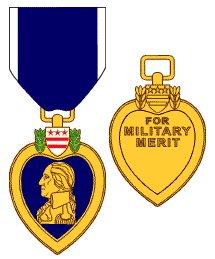
DESCRIPTION:A Purple heart within a Gold border, 1 3/8 inches wide, containing a profile of General George Washington. Above the heart appears a shield of the Washington Coat of Arms (a White shield with two Red bars and three Red stars in chief) between sprays of Green leaves. The reverse consists of a raised Bronze heart with the words "FOR MILITARY MERIT" below the coat of arms and leaves.
RIBBON: The ribbon is 1 3/8 inches wide and consists of the following stripes: 1/8 inch White 67101; 1 1/8 inches Purple 67115; and 1/8 inch White 67101.
CRITERIA:
a. The Purple Heart is awarded in the name of the President of the United States to any member of an Armed Force who, while serving with the U.S. Armed Services after 5 April 1917, has been wounded or killed, or who has died or may hereafter die after being wounded;
(1) In any action against an enemy of the United States;
(2) In any action with an opposing armed force of a foreign country in which the Armed Forces of the United States are or have been engaged;
(3) While serving with friendly foreign forces engaged in an armed conflict against an opposing armed force in which the United States is not a belligerent party;
(4) As a result of an act of any such enemy of opposing armed forces;
(5) As the result of an act of any hostile foreign force;
(6) After 28 March 1973, as a result of an international terrorist attack against the United States or a foreign nation friendly to the United States, recognized as such an attack by the Secretary of the department concerned, or jointly by the Secretaries of the departments concerned if persons from more than one department are wounded in the attack; or,
(7) After 28 March 1973, as a result of military operations, while serving outside the territory of the United States as part of a peacekeeping force.
(8) After 7 December 1941, by weapon fire while directly engaged in armed conflict, regardless of the fire causing the wound.
(9) While held as a prisoner of war or while being taken captive.
b. A wound for which the award is made must have required treatment by a medical officer.
COMPONENTS:
a. Decoration (regular size): MIL-D-3943/24; NSN for set 8455-00-269-5757; individual medal 8455-00-246-3833.
b. Decoration (miniature size): MIL-D-3943//24.
c. Ribbon: MIL-R-11589/126. NSN 8455-00-9948.
d. Lapel Button (metal replica of ribbon bar): MIL-L-11484/18. NSN 8455-00-253-0818.
BACKGROUND:
a. The original Purple Heart, designated as the Badge of Military Merit, was established by General George Washington by order from his headquarters at Newburgh, New York, August 7, 1782. The writings of General Washington quoted in part:
"The General ever desirous to cherish a virtuous ambition in his soldiers, as well as to foster and encourage every species of Military Merit, directs that whenever any singularly meritorious action is performed, the author of it shall be permitted to wear on his facings over the left breast, the figure of a heart in purple cloth or silk, edged with narrow lace or binding. Not only instances of unusual gallantry, but also of extraordinary fidelity and essential service in any way shall meet with a due reward".
b. So far as the known surviving records show, this honor badge was granted to only three men, all of them noncommissioned officers: Sergeant Daniel Bissell of the 2d Connecticut Regiment of the Continental Line; Sergeant William Brown of the 5th Connecticut Regiment of the Continental Line, and Sergeant Elijah Churchill of the 2d Continental Dragoons, which was also a Connecticut Regiment. The original Purple Heart depicted on the first page is a copy of the badge awarded to Sergeant Elijah Churchill and is now owned by the New Windsor Cantonment, National Temple Hill Association, PO Box 525, Vails Gate, NY 12584. The only other known original badge is the badge awarded to Sergeant William Brown and is in the possession of The Society of the Cincinnati, New Hampshire Branch but differs in design by not having any lettering embroidered on the heart and the leaves are at the top only with a larger spray of leaves at the base.
c. Subsequent to the Revolution, the Order of the Purple Heart had fallen into disuse and no further awards were made. By Order of the President of the United States, the Purple Heart was revived on the 200th Anniversary of George Washington's birth, out of respect to his memory and military achievements, by War Department General Orders No. 3, dated 22 February 1932. The criteria was announced in War Department Circular dated 22 February 1932 and authorized award to soldiers, upon their request, who had been awarded the Meritorious Service Citation Certificate or were authorized to wear wound chevrons subsequent to 5 April 1917.
d. During the early period of World War II (7 Dec 41 to 22 Sep 43), the Purple Heart was awarded both for wounds received in action against the enemy and for meritorious performance of duty. With the establishment of the Legion of Merit, by an Act of Congress, the practice of awarding the Purple Heart for meritorious service was discontinued. By Executive Order 9277, dated 3 December 1942, the decoration was extended to be applicable to all services and the order required that regulations of the Services be uniform in application as far as practicable. This executive order also authorized award only for wounds received.
e. Executive Order 10409, dated 12 February 1952, revised authorizations to include the Service Secretaries subject to approval of the Secretary of Defense. Executive Order 11016, dated 25 April 1962, included provisions for posthumous award of the Purple Heart. Executive Order 12464, dated 23 February 1984, authorized award of the Purple Heart as a result of terrorist attacks or while serving as part of a peacekeeping force subsequent to 28 March 1973.
f. The Senate approved an amendment to the 1985 Defense Authorization Bill on 13 June 1985, which changed the precedent from immediately above the Good Conduct Medal to immediately above the Meritorious Service Medals. Public Law 99-145 authorized the award for wounds received as a result of "friendly fire". Public Law 104-106 expanded the eligibility date, authorizing award of the Purple Heart to a former prisoner of war who was wounded before 25 April 1962.
g. The National Defense Authorization Act for Fiscal Year1998 (Public Law 105-85) changed the criteria to delete authorization for award of the Purple Heart Medal to any civilian national of the United States while serving under competent authority in any capacity with the Armed Forces. This change was effective 18 May 1998.
h. Order of precedence and wear of decorations is contained in Army Regulation 670-1. Policy for awards, approving authority, supply, and issue of decorations is contained in AR 600-8-22.
Meritorious Service Medal
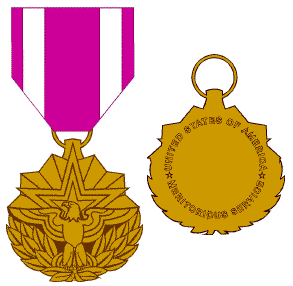
DESCRIPTION:A Bronze medal, 1 1/2 inches in diameter overall, consisting of six rays issuant from the upper three points of a five-pointed star with beveled edges and containing two smaller stars defined by incised outlines; in front of the lower part of the star an eagle with wings upraised standing upon two upward curving branches of laurel tied with a ribbon between the feet of the eagle. The reverse has the encircled inscriptions "UNITED STATES OF AMERICA" and " MERITORIOUS SERVICE".
RIBBON:
The ribbon is 1 3/8 inches wide and consists of the following stripes: 1/8 inch Crimson 67112; 1/4 inch White 67101; center 5/8 inch Crimson; 1/4 inch White; and 1/8 inch Crimson.
CRITERIA:
Awarded to members of the Armed Forces of the United States who distinguished themselves by outstanding non-combat meritorious achievement or service to the United States subsequent to 16 January 1969. Normally, the acts or services rendered must be comparable to that required for the Legion of Merit but in a duty of lesser though considerable responsibility.
COMPONENTS: The Second Class, Salvage, First Class and Master Diver Badges were approved on 15 February 1944. The Scuba was approved on 1 May 1969.
SUBDUED BADGES: The following are authorized components of the Meritorious Service Medal:
a. Decoration set (regular size): MIL-D-3943/66. NSN 8455-00-450-3728. Replacement medal NSN 8455-00-439-2142.
b. Decoration (miniature size): MIL-D-3943/66. Not stocked.
c. Ribbon: MIL-R-11589/172. NSN 8455-00-439-2143.
d. Lapel Button (metal replica of ribbon): MIL-L-11484/85. NSN 8455-00-439-2141.
BACKGROUND:
a. At Tri-Department Awards Conference, 5-6 February 1968, there was a discussion on the need for a third meritorious award to provide appropriate recognition for noncombat achievement or service comparable to the Bronze Star Medal for combat achievement or service. It was felt that the Legion of Merit’s prestige was slipping because it was being used with increasing frequency to reward service below Legion of Merit standard, but higher than that required for the Commendation Medal.
b. A proposed executive order was prepared in April 1968 and forwarded for approval to the Military Departments. An ad hoc committee was formed by the Secretary of Defense (M&RA) to select a name. On 8 November 1968, the committee unanimously approved the name "Meritorious Service Medal". President Johnson established the Meritorious Service Medal per Executive Order No. 11448 dated 16 January 1969. The Executive Order was amended by President Reagan per Executive Order 12312, dated 2 July 1981, to authorize award to members of the armed forces of friendly foreign nations.
c. The decoration was designed by Mr. Jay Morris, The Institute of Heraldry, and the design was approved by the committee on 20 March 1969. The ribbon design purposely follows the colors used for the Legion of Merit to reflect the parallel between the two medals. The eagle, symbol of the nation, stands on laurel branches denoting achievement. The star is used to represent the military service and the rays emanating therefrom denote the constant efforts of individuals to achieve through excellent and meritorious service.
d. Order of precedence and wear of decorations is contained in Army Regulation (AR) 670-1. Policy for awards, approving authority, supply, and issue of decorations is contained in AR 600-8-22.
Air Medal
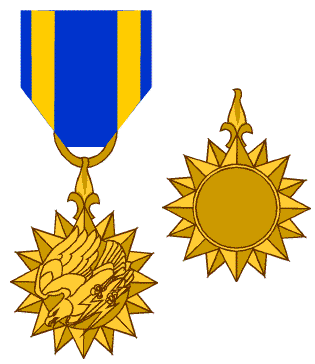
DESCRIPTION:Description: A Bronze compass rose 1 11/16 inches circumscribing diameter and charged with an eagle volant carrying two lightning flashes in its talons. A fleur-de-lis at the top point holds the suspension ring. The points of the compass rose on the reverse are modeled with the central portion plain for engraving the name of the recipient.
RIBBON:: The ribbon is 1 3/8 inches wide and consists of the following stripes: 1/8 inch Ultramarine Blue 67118; ¼ inch Golden Orange 67109; center 5/8 inch Ultramarine Blue; ¼ inch Golden Orange; and 1/8 inch Ultramarine Blue.
CRITERIA:
The Air Medal is awarded to any person who, while serving in any capacity in or with the armed forces of the United States, shall have distinguished himself by meritorious achievement while participating in aerial flight. Awards may be made to recognize single acts of merit or heroism or for meritorious service. Award of the Air Medal is primarily intended to recognize those personnel who are on current crew member or non-crew member flying status which requires them to participate in aerial flight on a regular and frequent basis in the performance of their primary duties. However, it may also be awarded to certain other individuals whose combat duties require regular and frequent flying in other than a passenger status or individuals who perform a particularly noteworthy act while performing the function of a crew member but who are not on flying status. These individuals must make a discernible contribution to the operational land combat mission or to the mission of the aircraft in flight. Examples of personnel whose combat duties require them to fly include those in the attack elements of units involved in air-land assaults against an armed enemy and those directly involved in airborne command and control of combat operations. Involvement in such activities, normally at the brigade/group level and below, serves only to establish eligibility for award of the Air Medal; the degree of heroism, meritorious achievement or exemplary service determines who should receive the award. Awards will not be made to individuals who use air transportation solely for the purpose of moving from point to point in a combat zone.
:COMPONENTS: The following are authorized components of the Air Medal and the applicable specifications for each:
a. Decoration (regular size): MIL-D-3943/23. NSN for decoration set is 8455-00-269-5747. For replacement medal NSN 8455-00-246-3837.
b. Decoration (miniature size): MIL-D-3943/23. NSN 8455-00-996-5002.
c. Ribbon: MIL-R-11589/7. NSN 8455-00-252-9963.>br>
d. Lapel Button: MIL-L-11484/17. NSN 8455-00-257-4308.
BACKGROUND:
a. In a letter from the Secretary of War to the Director, Bureau of Budget, dated 9 March 1942, the Secretary submitted a proposed executive order establishing the Air Medal for award to any person who, while serving in any capacity of the Army of the United States, distinguishes himself by meritorious achievement while participating in an aerial flight The Secretary of War, in his request, stated "The Distinguished Flying Cross is available only for heroism or extraordinary achievement while participating in aerial flight…It is desired not to cheapen the Distinguished Flying Cross by awarding it for achievement not bordering on the heroic. It is, however, important to reward personnel for meritorious service."
b. The Air Medal was authorized by President Roosevelt by Executive Order 9158, dated 11 May 1942, and established the award for "any person who, while serving in any capacity in the Army, Navy, Marine Corps or Coast Guard of the United States subsequent to September 8, 1939, distinguishes, or has distinguished, himself by meritorious achievement while participating in an aerial flight." Authorization was announced in War Department Bulletin No. 25, dated 25 May 1942. Executive Order 9242-A, dated 11 September 1942 amended the previous Executive Order to read "in any capacity in or with the Army".
c. In July 1942, the Office of The Quartermaster General (OQMG), forwarded a letter to twenty-two artists offering an opportunity to submit designs for consideration. The design selected was submitted by Walker Hancock and approved by the Secretary of War on 31 December 1942. The designer, Walker Hancock, had been inducted into the Army and assigned to Camp Livingston, Louisiana. He was ordered to temporary duty effective 16 November 1942 to G1 War Department to work on the medal. The Chief of Staff approved the ribbon design prepared by OQMG on 26 August 1942.
d. Oak leaf clusters were initially used to denote subsequent awards of the Air Medal. The number of additional awards were so great that the oak leaf clusters did not fit on the ribbon. As a result, the policy was changed in September 1968 to require the use of numbers to indicate subsequent awards of the Air Medal.
e. The Air Medal may be awarded for service during peacetime; however, approval authority for peacetime awards is not delegated to field commanders.
f. Order of precedence and wear of decorations is contained in Army Regulation (AR) 670-1. Policy for awards, approving authority, supply, and issue of decorations is contained in AR 600-8-22.
Joint Service Commendation Medal
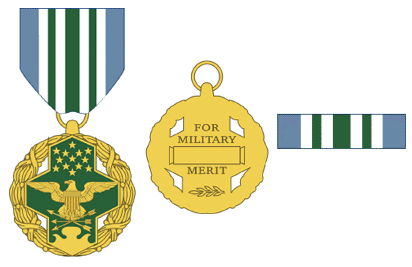
DESCRIPTION: On a device consisting of 4 conjoined hexagons, 2 vertically and 2 horizontally, of green enamel, an eagle with outspread wings charged on its breast with the shield of the United States and grasping in its talons 3 arrows (as depicted on the seal of the Department of Defense) all in gold between at top 13 gold stars and in base a gold stylized heraldic delineation representing land, sea and air, all within a gold circular laurel wreath bound with gold bands 1 5/8 inches (4.13 cm) in diameter, and with the areas between the inside of the wreath and the device pierced.
SYMBOLISM: The four hexagons (representing the Army, Navy, Air Force and Marine Corps Commendation Medals) are joined to symbolize the joint service nature of the award as does the stylized heraldic delineation representing land, sea and air. The eagle, shield of the United States, arrows and thirteen stars are taken from the seal of the Department of Defense and refer to the medal being awarded in the name of the Secretary of Defense. The gold laurel wreath and gold color signify achievement and award. The color green is symbolic of faithfulness and unity.
RIBBON: A ribbon 1 3/8 inches (3.49 cm) in width, composed of a 1/4 inch (.64 cm) Bluebird stripe, a 1/8 inch (.32 cm) White stripe, a 3/32 inch (.24 cm) Myrtle Green stripe, a 1/8 inch (.32 cm) White stripe, a 3/16 inch (.48 cm) Myrtle Green stripe, a 1/8 inch (.32 cm) White stripe, a 3/32 inch (.24 cm) Myrtle Green stripe, a 1/8 inch (.32 cm) White stripe and a 1/4 inch (.64 cm) Bluebird stripe.
SYMBOLISM: The green (same shade as the green enamel on the pendant) and white stripes of the ribbon were suggested by the ribbons of the Army and Navy Commendation Medals. The broad stripes of blue (Bluebird) flanking the white and green stripes refer to the Department of Defense.
BACKGROUND: The Joint Service Commendation Medal (JSCM) was authorized by the Secretary of Defense on 25 June 1963. It is awarded in the name of the Secretary of Defense to members of the Armed Forces of the United States who, after 1 January 1963, distinguished themselves by meritorious achievement or service. The prescribing directive for the JSCM is DOD 1348.33-M, Manual of Military Decorations & Awards.
Army Commendation Medal
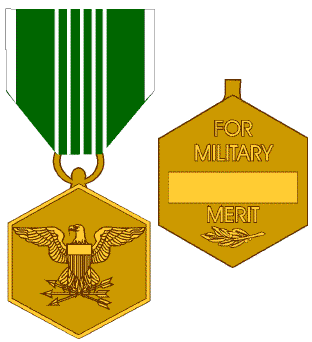
DESCRIPTION: On a 1 3/8 inches wide Bronze hexagon, one point up, an American bald eagle with wings displayed horizontally, grasping three crossed arrows and bearing on its breast a shield paly of thirteen pieces and a chief. On the reverse, a name panel between the words "FOR MILITARY" and "MERIT", all above a sprig of laurel.
RIBBON: The ribbon is 1 3/8 inches wide and consists of the following stripes: 3/32 inch White 67101; 25/64 inch Myrtle Green 67190; 1/32 inch White; 1/16 inch Myrtle Green; 1/32 inch White; 1/16 inch Myrtle Green; center 1/32 inch White; 1/16 inch Myrtle Green; 1/32 inch White; 1/16 inch Myrtle Green; 1/32 inch White; 25/64 inch Myrtle Green; and 3/32 inch White.
CRITERIA:
a. The Army Commendation Medal is awarded to any member of the Armed Forces of the United States other than General Officers who, while serving in any capacity with the Army after 6 December 1941, distinguished himself by heroism, meritorious achievement or meritorious service. Award may be made to a member of the Armed Forces of a friendly foreign nation who, after 1 June 1962, distinguishes himself by an act of heroism, extraordinary achievement, or meritorious service which has been of mutual benefit to a friendly nation and the United States.
b. Awards may be made for acts of valor performed under circumstances described above which are of lesser degree than required for award of the Bronze Star Medal. These acts may involve aerial flight. An award may be made for acts of noncombatant-related heroism which do not meet the requirements for an award of the Soldier’s Medal.
COMPONENTS: The following are authorized components of the Army Commendation Medal:
a. Decoration (regular size): MIL-D-3943/27. NSN 8455-00-269-5750 for the decoration set. NSN 8455-00-246-3820 for individual replacement medal.
b. Decoration (miniature size): MIL-D-3943/27. NSN 8455-00-996-5003.
c. Ribbon: MIL-R-11589/37. NSN 8455-00-257-3898.
d. Lapel Button: MIL-L-11484/20. NSN 8455-00-269-5423.
BACKGROUND: a. In a summary sheet, 5 November 1945, WDGAP, Personnel Division recommended that an Army Commendation Ribbon of distinctive design be established to recognize meritorious service in an area at a time for which the Bronze Star Medal may not be awarded. The recommendation was approved by the Secretary of War and the ribbon was established by War Department Circular 377, dated 18 December 1945. This circular authorized award to "members of the Armed Forces of the United States serving in any capacity with the Army for meritorious service rendered since 7 December 1941, not in sustained operational activities against an enemy nor in direct support of such operation, i.e., in areas and at times when the Bronze Star Medal may not be awarded because of its operational character". Authority to award the Commendation Ribbon was delegated to Major Generals or commanders of any command, force or installation normally commanded by Major Generals.
b. In a DF, 29 April 1948, from the D/PA to the Quartermaster General, the Personnel & Admin. Division indicated that the Secretary of the Army and the Secretary of the Air Force had authorized a medal pendant to be established for the Commendation Ribbon and requested that a proposed design be prepared. The design was approved by both Secretaries on 8 July 1948. The Medal Pendant for Commendation Ribbon was announced in Department of the Army (DA) Circular 91 (AF Letter 35-25) dated 20 July 1949. On 20 March 1950, the Secretary of the Navy approved the Navy Commendation Ribbon, and authorized use of the same pendant with a different ribbon on 6 April 1950.
c. DA General Order No. 10, dated 31 March 1960, renamed the Commendation Ribbon with Medal Pendant to the Army Commendation Medal. President Kennedy, in a memorandum to the Secretary of Defense, dated 1 June 1962, authorized the award of the Army Commendation Medal to members of the Armed Forces of friendly foreign nations who, after 1 June 1962, distinguished themselves by an act of heroic, extraordinary achievement, or meritorious service.
d. Order of precedence and wear of decorations is contained in Army Regulation (AR) 670-1. Policy for awards, approving authority, supply, and issue of decorations is contained in AR 600-8-22.
Army Achievement Medal
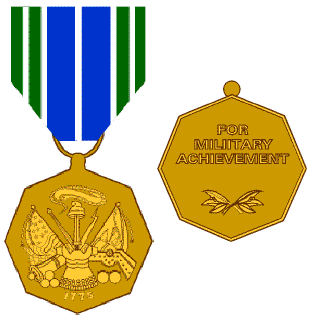
DESCRIPTION: A Bronze octagonal medal, 1 1/2 inches in diameter, with one angle at the top centered. On the obverse is a design consisting of the elements of the Department of the Army (DA) plaque and the date "1775" at the bottom. On the reverse, in three lines, are the words "FOR MILITARY ACHIEVEMENT" above a space for inscription and below there are two slips of laurel.
Ribbon: The ribbon is 1 3/8 inches wide and consists of the following stripes: 1/8 inch Green 67129; 1/16 inch White 67101; 1/8 inch Green; 1/16 inch White; 9/32 inch Ultramarine Blue 67118; center 1/16 inch White; 9/32 inch Ultramarine Blue; 1/16 inch White; 1/8 inch Green; 1/16 inch White; and 1/8 inch Green.
CRITERIA:
The Army Achievement Medal is awarded to any member of the armed forces of the United States, or to any member of the armed forces of a friendly foreign nation, who while serving in any capacity with the Army in a non-combat area on or after 1 August 1981, distinguished himself by meritorious service or achievement of a lesser degree than required for award of the Army Commendation Medal. The Army Achievement Medal will not be awarded to general officers.
COMPONENTS: The following are authorized components of the Army Achievement Medal:
a. Decoration (regular size): MIL-D-3943/102. NSN 8455-01-127-7338 for decoration set. NSN 8455-01-128-2438 for individual medal.
b. Decoration (miniature size): MIL-D-3943/102. NSN 8455-01-128-2439.
c. Ribbon: MIL-R-11589/280. NSN 8455-01-128-2440.
d. Lapel Button: MIL-L-11484/135. NSN 8455-01-128-1849.
BACKGROUND:
a. As part of the Army Cohesion and Stability Study (ARCOST) of 1980, a recommendation was made to establish the Army Achievement Medal, Overseas Service Ribbon, Army Service Ribbon, and the NCO Professional Development Ribbon. On 18 February 1981, MILPERCEN requested TIOH initiate action to develop the recommended awards. Designs were prepared by TIOH and forwarded to MILPERCEN on 18 March 1981. On 10 April 1981, the Secretary of the Army approved establishment of the decorations recommended by the ARCOST group. On 13 April 1981, the DCSPER approved a design which had been submitted by TIOH and directed development be initiated.
b. Order of precedence and wear of decorations is contained in Army Regulation (AR) 670-1. Policy for awards, approving authority, supply, and issue of decorations is contained in AR 600-8-22.
PRISONER OF WAR
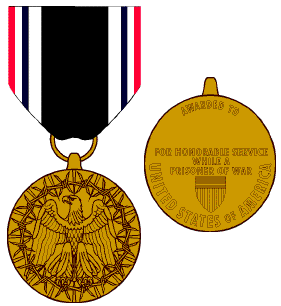
DESCRIPTION: On a Bronze medal, 1 3/8 inches in diameter, an eagle with wings opened surrounded by a circle of barbed wire and bayonet points. The reverse has the inscription "AWARDED TO" around the top and "FOR HONORABLE SERVICE WHILE A PRISONER OF WAR" across the center in three lines with a space between the two inscriptions for engraving the name of the recipient. The shield of the Coat of Arms of the United States is centered on the lower part of the reverse side with the inscription "UNITED STATES OF AMERICA" around the bottom of the medal.
RIBBON: The ribbon is 1 3/8 inches wide and consists of the following stripes: 1/16 inch Old Glory Red 67156; 3/32 inch White 67101; 1/16 inch Old Glory Blue 67178; 1/8 inch White; center 11/16 inch Black 67138; 1/8 inch White; 1/16 inch Old Glory Blue; 3/32 inch White; and 1/16 inch Old Glory Red.
CRITERIA:
a. The Prisoner of War Medal is issued only to those U.S. military personnel who were taken prisoner and held captive after 5 April 1917;
(1) While engaged in an action against an enemy of the United States;
(2) While engaged in military operations involving conflict with an opposing foreign force; or
(3) While serving with friendly forces engaged in an armed conflict against an opposing force in which the United States is not a belligerent party.
b. Civilians who have been credited with military service which included the period of captivity are also eligible for the medal.
c. Hostages of terrorists and persons detained by governments with which the United States is not engaged actively in armed conflict are not eligible for the medal.
COMPONENTS: The following are components of the Prisoner of War Medal:
a. Medal (regular size): MIL-M-3946/53. NSN 8455-01-251-2096 for set which includes regular size medal and ribbon bar.
b. Medal (miniature size): MIL-DTL-3943/241. Available commercially.
c. Ribbon: MIL-DTL-11589/319. Available commercially.
d. Lapel Button: MIL-DTL-11484/152. Available commercially.
BACKGROUND:
a. Public Law 99-145, Department of Defense Authorization Act, dated 8 November 1985, amended Chapter 57 of Title 10, USC, 1128, to require under certain circumstances the issuance of a Prisoner of War Medal to any person who, while serving in any capacity with the Armed Forces of the United States, was taken prisoner and held captive after 5 April 1917.
b. As a result of the above law, DOD solicited designs from all sources, and on 29 November 1985, designated The Institute of Heraldry (TIOH) as the Executive Agency for designing and procuring the medal. Over 300 designs were received and referred to a committee, comprised of representatives of the Armed Services, for advising the Secretary of Defense on a selection.
c. The design selected was created by Mr. Jay C. Morris of The Institute of Heraldry. The symbolism of the design is as follows: The eagle, a symbol of the United States and the American spirit, though surrounded by barbed wire and bayonet points, stands with pride and dignity, continually on the alert for the opportunity to seize hold of beloved freedom, thus symbolizing the hope that upholds the spirit of the prisoner of war. The ribbon colors red, white, and blue are symbolic of our National colors while determination to survive in or to escape from a hostile environment.
d. Order of precedence and wear policy for medals awarded to Army personnel is contained in AR 670-1. Policy for awards, approving authority and supply of medals is contained in AR 600-8-22.
Good Conduct Medal
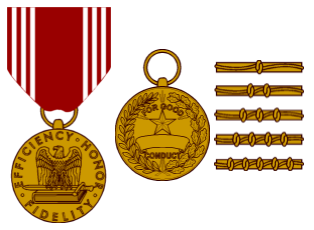
DESCRIPTION: A Bronze medal, 1 1/4 inches in diameter, with an eagle, wings spread, standing on a closed book and sword, encircled by the words "EFFICIENCY HONOR FIDELITY". On the reverse is a five-pointed star and a scroll between the words "FOR GOOD" and "CONDUCT", surrounded by a wreath formed by a laurel branch on the left and an oak branch on the right. Clasps are placed on the ribbon to represent subsequent awards.
RIBBON A 1 3/8 inches ribbon consisting of the following stripes: 1/16 inch Soldier Red 67157; 1/16 inch White 67101; 1/16 inch Soldier Red; 1/16 inch White; 1/16 inch Soldier Red; 1/16 inch White; center 5/8 inch Soldier Red; 1/16 inch White; 1/16 inch Soldier Red; 1/16 inch White; 1/16 inch Soldier Red; 1/16 inch White; and 1/16 inch Soldier Red.
CRITERIA:
a. The Good Conduct Medal is awarded for exemplary behavior, efficiency, and fidelity in active Federal Military service. It is awarded on a selective basis to each soldier who distinguishes himself from among his/her fellow soldiers by their exemplary conduct, efficiency, and fidelity throughout a specified period of continuous enlisted active Federal military service. Qualifying periods of service include each three years completed after 27 August 1940 or, for first award only, upon completion of at least one year upon termination of service if separated prior to three years. The immediate commander must approve the award and the award must be announced in permanent orders.
b. Effective 1 September 1982, Active Guard Reserve personnel became eligible for award of the Good Conduct Medal. For Active Guard Reserve personnel, the Good Conduct Medal qualification period may commence at a time during the three years immediately preceding the 1 September 1982 effective date, provided no portion of service for the Good Conduct Medal is included in a period of service for which the Army Reserve Components Achievement Medal was awarded.
COMPONENTS: The following are authorized components:
a. Medal (regular size): MIL-DTL-3943/191. NSN 8455-00-269-5761 for set which includes regular size medal and ribbon bar.
b. Medal (miniature size): MIL-DTL-3943/191. Commercially available from certified manufacturers.
c. Ribbon: MIL-DTL-11589/68. NSN 8455-00-257-0571. Commercially available from certified manufacturers.
d. Lapel Button (metal replica of ribbon): MIL-DTL-11484/48. Commercially available from certified manufacturers.
BACKGROUND:
a. The Good Conduct Medal was established by Executive Order 8809, dated 28 June 1941, and authorized the award for soldiers completing three years active service after that date. The criteria was amended by Executive Order 9323, dated 31 March 1943, to authorize award for three years service after 7 December 1941 or one year service while the United States is at war. Executive Order 10444, dated 10 April 1953, revised the criteria to authorize award for three years service after 27 August 1940; one year service after 7 December 1941 while the United States is at war; and award for the first award for service after 27 June 1950 upon termination of service, for periods less than three years, but more than one year.
b. The medal was designed by Mr. Joseph Kiselewski and approved by the Secretary of War on 30 October 1942. The eagle, with wings spread, denotes vigilance and superiority. The horizontal sword denotes loyalty, and the book represents knowledge acquired and ability gained. On the reverse, the lone star denotes merit. The wreath of laurel and oak leaves denotes reward and strength.
c. The second and subsequent awards are indicated by the wear of the clasp with loop on the ribbon. Bronze clasps indicate the second (two loops) through fifth award (five loops); silver clasps indicate sixth (one loop) through tenth award (five loops); and gold clasps indicate eleventh (one loop) through the fifteenth award (5 loops).
ARMY RESERVE COMPONENTS ACHIEVEMENT MEDAL
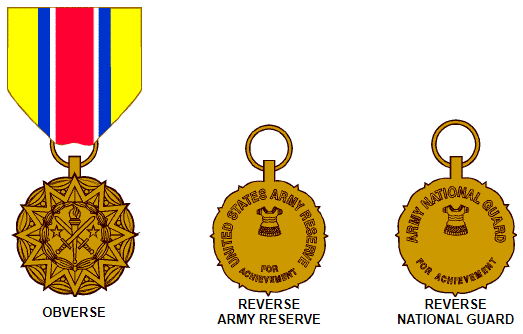
DESCRIPTION: A Bronze medal, 1 ¼ inches in diameter, consisting of a faceted twelve-pointed star with a beveled edge, the points surmounting a wreath of laurel and bearing on a disc within a smaller wreath of laurel, a torch between two swords crossed saltirewise, points up and flanked by two mullets. The reverse has the cuirass from the Department of the Army seal centered below "ARMY NATIONAL GUARD" or "UNITED STATES ARMY RESERVE" and above "FOR ACHIEVEMENT".
RIBBON: A 1 3/8 inches wide ribbon consisting of the following stripes: 5/16 inch Old Gold 67105; 1/8 inch Ultramarine Blue 67118; 1/16 inch White 67101; center 3/8 inch Scarlet 67111; 1/16 inch White; 1/8 inch Ultramarine Blue; and 5/16 inch Old Gold.
CRITERIA: The Army Reserve Components Achievement Medal is awarded for exemplary behavior, efficiency, and fidelity while serving as a member of an Army National Guard or Army Reserve Troop Program Unit or as an individual mobilization augmentee for each four year period since 3 March 1972. Effective 28 March 1995, the period of qualifying service for the award was reduced from four years to three years; however, this change was not retroactive. Service must have been consecutive and service performed in the Reserve Component of the U.S. Air Force, Navy, Marine Corps, or Coast Guard may not be credited for award of this medal. The member must have exhibited honest and faithful service in accordance with the standards of conduct, courage and duty required by law and customs of the service of a member of the same grade as the individual to whom the standard is being applied. A member must be recommended for the award by his/her unit commander.
COMPONENTS The following are authorized components of the Army Reserve Components Achievement Medal:
a. Medal (regular size): MIL-DTL-3943/200. NSN 8455-00-464-2138 (National Guard) and 8455-00-464-2149 (Army Reserve) for set which includes full size medal and ribbon bar.
b. Medal (miniature size): MIL-DTL-3943/200. Available commercially.
c. Ribbon: MIL-DTL-11589/196. NSN 8455-00-444-2171.
d. Lapel Button (metal replica of ribbon): MIL-DTL-11484/101. Available commercially.
BACKGROUND:
a. The Commanding General, U.S. Continental Army Command, recommended adoption of a medal for the Reserve Components that would be comparable to the Good Conduct Medal for the Active Army on 11 August 1969. The Deputy Chief of Staff for Personnel, on 29 January 1970, requested The Institute of Heraldry (TIOH) provide proposed designs for consideration by the Secretary of the Army. Designs were submitted in May 1970 and the Secretary of the Army approved the award on 3 March 1971.
b. The star symbolizes achievement and its twelve points refer to measurement of time and to the sustained meritorious service. The inner disc represents a circle of perfection and bears the torch for guidance and the laurel for honor and glory. The two swords, one for active and one for reserve, attest to eternal readiness and the two stars symbolize equality of effort. The red, white and blue of the ribbon, our National colors, stand for patriotism. The gold symbolizes merit.
c. The Army Reserve Components Achievement Medal may be awarded to enlisted personnel and officers in the grade of Colonel or below. AGR soldiers and officers are not authorized the ARCAM. Subsequent awards are reflected by the attachment of an oak-leaf cluster to the ribbon.
WORLD WAR I VICTORY MEDAL
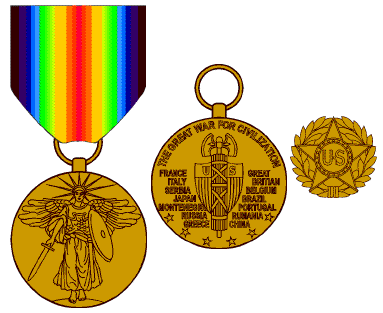
DESCRIPTION: The medal is Bronze and 1 3/8 inches in diameter. On the obverse is a winged Victory, standing full length and full face. On the reverse is the inscription "THE GREAT WAR FOR CIVILIZATION" and the United States shield with the letters "U.S." surmounted by a fasces, and on either side the names of the allied and associated nations. The lapel button is a five-pointed star 5/8-inch in diameter on a wreath with the letters "U.S." in the center.
RIBBON: The medal is suspended by a ring from a silk ribbon 1 3/8 inches in width, representing two rainbows placed in juxtaposition and having the red in the middle.
CRITERIA:
a. The World War I Victory Medal was awarded for honorable service for active duty at any time between 6 April 1917 and 11 November 1918. It was also awarded for service between 12 November 1918 and 5 August 1919, with the American Expeditionary Forces in European Russia, and was awarded to the American Expeditionary Forces in Siberia between 23 November 1918 and 1 April 1920.
b. Battle clasps were awarded for each of the major operations for individuals actually present under competent orders. The clasps, with a star on each side of the name of the campaign or one of the defensive sectors, were worn on the suspension ribbon for the following campaigns:
Cambrai: 20 May - 4 Dec 1917
Somme Defensive: 21 Mar - 6 Apr 1918
Lys: 9 Apr - 27 Apr 1918
Aisne: 27 May - 5 Jun 1918
Montdidier-Noyon: 9 Jun - 13 Jun 1918
Champagne-Marne: 18 Jul - 6 Aug 1918
Aisne-Marne: 18 Jul - 6 Aug 1918
Somme Offensive: 8 Aug - 11 Nov 1918
Oise-Aisne: 18 Aug - 11 Nov 1918
Ypres-Lys: 19 Aug - 11 Nov 1918
St. Mihiel: 12-16 Sep 1918
Meuse-Argonne: 26 Sep - 11 Nov 1918
Vittorio-Veneto: 24 Oct - 4 Nov 1918
c. Clasps were awarded to personnel who served overseas in one of the following areas and were not entitled to a battle clasp:
England: 6 Apr 1917 - 11 Nov 1918
France: 6 Apr 1917 - 11 Nov 1918
Italy: 6 Apr 1917 - 11 Nov 1918
Siberia: Any service in Siberia
Russia: Any service in European Russia
d. The lapel button is bronze, except that personnel who were wounded in action were awarded a silver lapel button.
COMPONENTS: The following components are authorized:
a. Medal (regular and miniature sizes): MIL-DTL-3943/236.
b. Ribbon: MIL-DTL-11589/148.
c. Lapel Button: MIL-DTL-11484/47
d. Streamers. Streamers are displayed on the organizational flag to represent campaign participation. The inscription on the organizational streamer will be as indicated in the unit's lineage and honors.
BACKGROUND:
a. The medal was established by an Act of Congress, 1919, and promulgated by War Department General Orders 48, 1919, which was rescinded by War Department General Orders 83, 30 Jun 1919.
b. The 14 Allied Nations decided on a single ribbon, but pendant design was left up to each Nation. Mr. James E. Fraser was the designer of the U.S. Victory Medal.
c. The Victory Medal ribbon pattern is used in thirteen streamers displayed on the Army flag to represent World War I service. The inscriptions for the streamers displayed on the Army flag are listed in AR 840-10.
ARMY OCCUPATION OF GERMANY WORLD WAR I

DESCRIPTION:
The medal is Bronze and 1 ¼ inches in diameter. On the obverse is a profile of General John J. Pershing, encircled by four stars indicating his insignia of grade as Commanding General of the Field Forces. In the lower left is the inscription "GENERAL JOHN J. PERSHING" and on the right is a laurel wreath superimposed by a sword with the dates "1918" and "1923" enclosed by the wreath. The reverse shows the American eagle perched with outspread wings standing on the Castle Ehrenbreitstein, encircled by the words "U.S. ARMY OF OCCUPATION OF GERMANY" and three stars at the bottom of the medal.
RIBBON: The ribbon is 1 3/8 inches in width consisting of the following stripes: 1/16 inch Ultramarine Blue 67118; 1/16 inch Scarlet 67111; 3/16 inch White 67101; ¾ inch Black 67138 (center); 3/16 inch White; 1/16 inch Scarlet; 1/16 inch Ultramarine Blue.
CRITERIA: The Army of Occupation of Germany Medal was awarded for honorable service in Germany or Austria-Hungary between 12 November 1918 and 11 July 1923.
COMPONENTS:The following components are authorized:
a. Medal (regular and miniature sizes): MIL-DTL-3943/245.
b. Ribbon: MIL-STD-11589/15
BACKGROUND:
a. The medal was established by Public Law 322, 77th Congress on 21 November 1941, and announced in War Department Bulletin 34, dated 10 December 1941, and War Department Circular 176 dated 6 June 1942.
b. The medal was designed by Mr. T. A. Rovelstad, Heraldic Division, Office of the Quartermaster General, in June 1942, and was approved by the Secretary of War on 8 July 1942.
c. The obverse of the medal includes the dates of the U.S. Occupation of Germany. The reverse depicts the eagle standing on the Castle of Ehrenbreitstein, which overlooks the Rhine in Coblenz, Germany. The three stars on the reverse symbolize the Third Army, which comprised the occupation forces of Germany
AMERICAN DEFENSE SERVICE MEDAL
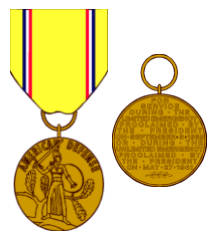
DESCRIPTION:
The Bronze medal is 1 ¼ inches in width. On the obverse is a female Grecian figure symbolic of defense, holding in her sinister hand an ancient war shield in reverse and her dexter hand brandishing a sword above her head, and standing upon a conventionalized oak branch with four leaves. Around the top is the lettering "AMERICAN DEFENSE". On the reverse is the wording "FOR SERVICE DURING THE LIMITED EMERGENCY PROCLAIMED BY THE PRESIDENT ON SEPTEMBER 8,1939 OR DURING THE UNLIMITED EMERGENCY PROCLAIMED BY THE PRESIDENT ON MAY 27,1941" above a seven-leafed spray of laurel. The foreign service clasp is a Bronze bar 1/8 inch in width and 1-1/2 inches in length with the words "FOREIGN SERVICE", with a star at each end of the inscription. The foreign service clasp is placed on the suspension ribbon of the medal.
RIBBON The ribbon is 1 3/8 inches wide and consists of the following stripes: 3/16 inch Golden Yellow 67104; 1/8 inch triparted Old Glory Blue 67178; White 67101; and Scarlet 67111; center ¾ inch Golden Yellow; 1/8 inch triparted Scarlet; White; and Old Glory Blue 67178; and 3/16 inch Golden yellow.
CRITERIA:
The American Defense Service Medal was awarded to personnel for active duty service from 8 September 1939 to 7 December 1941 for a period of twelve months or longer.
COMPONENTS:The following are authorized components:
a. Medal (regular size): MIL-DTL-3943/228. Medal set with full size medal and ribbon bar. NSN: 8455-00-269-5780.
b. Medal (miniature): MIL-DTL-3943/228. Available commercially.
c. Ribbon: MIL-DTL-11589/10. NSN: 8455-00-257-0513. Available commercially.
d. Foreign Service Clasp: MIL-R-41819/9. NSN: 8455-00-249-0187.
BACKGROUND:
a. The American Defense Service Medal was established per Executive Order 8808, dated 28 June 1941, by President Franklin D. Roosevelt and announced in War Department Bulletin 17, 1941. The criteria was announced in Department of the Army Circular 44, dated 13 February 1942.
b. The ribbon design was approved by the Secretary of War and the Secretary of Navy on January 7, 1942. The golden yellow color was symbolic of the golden opportunity of the youth of the United States to serve the National colors, represented by the blue, white and red pin stripes on each side.
c. The medal was designed by Mr. Lee Lawrie, a civilian sculptor from Easton, Maryland. The model was approved by the Commission of Fine Arts on May 5, 1942.
d. The foreign service clasp is worn on the suspension ribbon to indicate service outside the Continental United States. A bronze star is worn on the service ribbon in lieu of the foreign service clasp.
WOMEN'S ARMY CORPS SERVICE MEDAL
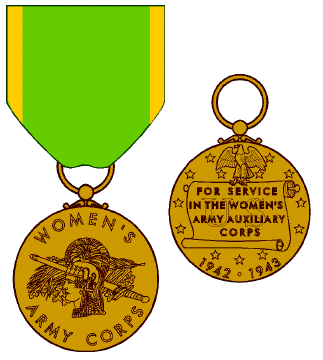
DESCRIPTION: A Bronze medal, 1 ¼ inches in diameter, with the head of Pallas Athene in profile facing right, superimposed on a sheathed sword cross with oak leaves and a palm branch within a circle composed of the words "WOMEN’S" in the upper half, and in the lower half "ARMY CORPS". On the reverse, within an arrangement of 13 stars, is a scroll bearing the words "FOR SERVICE IN THE WOMEN’S ARMY AUXILIARY CORPS" in front of the letters "U S" in lower relief. At the top and perched on the scroll is an eagle with wings elevated and displayed and at the bottom, the date "1942-1943".
RIBBON: The ribbon is 1 3/8 inches wide and consists of the following stripes: 1/8 inch Old Gold 67105; 1 1/8 inch Mosstone Green 67127; and 1/8 inch Old Gold.
CRITERIA: The Women’s Army Corps Service Medal was awarded for service in both the Women’s Army Auxiliary Corps during the period 10 Jul 42 - 31 Aug 43 and the Women’s Army Corps during the period 1 Sep 43 - 2 Sep 45.
COMPONENTS: The following are authorized components of the Women’s Army Corps Service medal:
a. Medal (regular size): MIL-DTL-3943/199.
b. Medal (miniature size): MIL-STD-3943/199. Available commercially.
c. Ribbon: MIL-STD-11589/153. Available commercially.
d. Lapel Button: Available commercially.
AMERICAN CAMPAIGN MEDAL
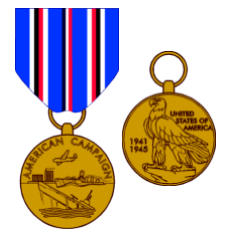
DESCRIPTION: The Bronze medal is 1 ¼ inches in width. On the obverse is a Navy cruiser under full steam with a B-24 airplane flying overhead with a sinking enemy submarine in the foreground on three wave symbols, in the background a few buildings representing the arsenal of democracy, above the scene the words "AMERICAN CAMPAIGN". On the reverse an American bald eagle close between the dates "1941 - 1945" and the words "UNITED STATES OF AMERICA".
Ribbon: The ribbon is 1 3/8 inches wide and consists of the following stripes: 3/16 inch Oriental Blue 67172; 1/16 inch White 67101; 1/16 inch Black 67138; 1/16 inch Scarlet 67111; 1/16 inch White; 3/16 inch Oriental Blue; center 1/8 triparted Old Glory Blue 67178, White and Scarlet; 3/16 inch Oriental Blue; 1/16 inch White; 1/16 inch Scarlet; 1/16 inch Black; 1/16 inch White; and 3/16 inch Oriental Blue.
CRITERIA:
a. The American Campaign Medal was awarded to personnel for service within the American Theater between 7 December 1941 and 2 March 1946 under any of the following conditions.
(1) On permanent assignment outside the continental limits of the United States.
(2) Permanently assigned as a member of a crew of a vessel sailing ocean waters for a period of 30 days or 60 nonconsecutive days.
(3) Permanently assigned as a member of an operating crew of an airplane actually making regular and frequent flights over ocean waters for a period of 30 days.
(4) Outside the continental limits of the United States in a passenger status or on temporary duty for 30 consecutive days or 60 days not consecutive.
(5) In active combat against the enemy and was awarded a combat decoration or furnished a certificate by the commanding general of a corps, higher unit, or independent force that he actually participated in combat.
(6) Within the continental limits of the United States for an aggregate period of one year.
b. The eastern boundary of the American Theater is from the North Pole, south along the 75th meridian west longitude to the 77th parallel north latitude, then southeast through Davis Strait to the intersection of the 40th parallel north latitude and the 35th meridian west longitude, then south along the meridian to the 10th parallel north latitude, then southeast to the intersection of the Equator and the 20th meridian west longitude, then south along the 20th meridian west longitude to the South Pole. The western boundary is from the North Pole, south along the 141st meridian west longitude to the east boundary of Alaska, then south and southeast along the Alaska boundary to the Pacific Ocean, then south along the 130th meridian to its intersection with the 30th parallel north latitude, then southeast to the intersection of the Equator and the 100th meridian west longitude to the South Pole. The American Theater included North America (excluding Alaska) and South America.
COMPONENTS: The following are authorized components:
a. Medal (regular size): MIL-DTL-3943/227. Medal set with full size medal and ribbon bar. NSN 8455-00-269-5760.
b. Medal (miniature size): MIL-DTL-3943/227. Available commercially.
c. Ribbon: MIL-DTL-11589/9. NSN 8455-00-257-0517. Available commercially.
d. Streamer: The American Campaign ribbon is used as a streamer. The Army displays only one streamer on the Army flag, that of the Antisubmarine Campaign, because there were no Army units that received campaign participation credit for the other two designated campaigns.
BACKGROUND:
a. The American Campaign Medal was established per Executive Order 9265, dated 6 November 1942, by President Franklin D. Roosevelt and announced in War Department Bulletin 56, 1942. The criteria was initially announced in Department of the Army (DA) Circular 1, dated 1 January 1943, so that the ribbon could be authorized prior to design of the medal. The criteria for the medal was announced in DA Circular 84, dated 25 March 1948 and subsequently published in Army Regulation 600-65, dated 22 September 1948.
b. The ribbon design was approved by the Secretary of War on 24 November 1942. The blue color represents the Americas; the central blue, white and red stripes (taken from the American Defense Service Medal ribbon) refers to the continuance of American defense after Pearl Harbor. The white and black stripes refer to the German part of the conflict on the Atlantic Coast, while the red and white stripes are for the Japanese colors and refer to that part of the conflict on the Pacific Coast.
c. The medal was designed by Mr. Thomas Hudson Jones. The reverse side was designed by Mr. A. A. Weinman and is the same design as used on the reverse of the European-African-Middle Eastern and Asiatic-Pacific Campaign Medals. The first medal was presented to General of the Army George C. Marshall on 17 December 1947.
d. One bronze star is worn on the ribbon to indicate participation in an authorized campaign. There were three campaigns in the American Theater:
*(1) Antisubmarine: 7 Dec 41 - 2 Sep 45.
*(2) Ground Combat: 7 Dec 41 - 2 Sep 45.
*(3) Air Combat: 7 Dec 41 - 2 Sep 45.
* These campaigns are not displayed as streamers on the Army flag.
ASIATIC-PACIFIC CAMPAIGN MEDAL
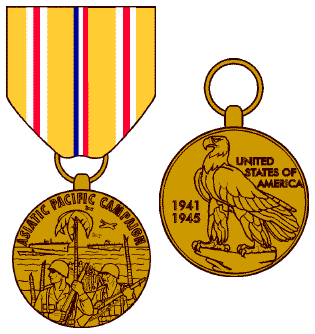
DESCRIPTION: The Bronze medal is 1-1/4 inches in width. On the obverse is a tropical landing scene with a battleship, aircraft carrier, submarine and an aircraft in the background with landing troops and palm trees in the foreground with the words "ASIATIC PACIFIC CAMPAIGN" above the scene. On the reverse, an American bald eagle close between the dates "1941 - 1945" and the words "UNITED STATES OF AMERICA".
RIBBON: The ribbon is 1 3/8 inches wide and consists of the following stripes: 3/16 inch Yellow 67108; 1/16 inch White 67101; 1/16 inch Scarlet 67111; 1/16 inch White; ¼ inch Yellow; center 1/8 triparted Old Glory Blue 67178, White and Scarlet; ¼ inch Yellow; 1/16 inch White; 1/16 inch Scarlet; 1/16 inch White; and 3/16 inch Yellow.
CRITERIA:
a. The Asiatic-Pacific Campaign Medal was awarded to personnel for service within the Asiatic-Pacific Theater between 7 December 1941 and 2 March 1946 under any of the following conditions:
(1) On permanent assignment.
(2) In a passenger status or on temporary duty for 30 consecutive days or 60 days not consecutive.
(3) In active combat against the enemy and was awarded a combat decoration or furnished a certificate by the commanding general of a corps, higher unit, or independent force that he actually participated in combat.
b. The eastern boundary of the Asiatic-Pacific Theater is from the North Pole, south along the 141st meridian west longitude to the east boundary of Alaska, then south and southeast along the Alaska boundary to the Pacific Ocean, then south along the 130th meridian to its intersection with the 30th parallel north latitude, then southeast to the intersection of the Equator and the 100th meridian west longitude, then to the South Pole. The western boundary of the Asiatic-Pacific Theater is from the North Pole south along the 60th meridian east longitude to its intersection with the east boundary of Iran, then south along the Iran boundary to the Gulf of Oman and the intersection of the 60th meridian east longitude, then south along the 60th meridian east longitude to the South Pole. The Asiatic-Pacific Theater included Alaska, Hawaii, Philippines, Australia, New Zealand, and all of Asia.
COMPONENTS:The following are authorized components:
a. Medal (regular size): MIL-DTL-3943/247. Medal set with full size medal and ribbon bar. NSN 8455-00-269-5764.
b. Medal (miniature): MIL-DTL-3943/247. Available commercially.
c. Ribbon: MIL-DTL-11589/17. NSN 8455-00-257-0525. Available commercially.
d. Streamer: The Asiatic-Pacific Campaign ribbon is used as a streamer for 21 streamers on the Army flag. Units that received campaign credit display the streamers with the inscription as listed on their lineage and honors.
BACKGROUND:
a. The Asiatic-Pacific Campaign Medal was established per Executive Order 9265, dated 6 November 1942, by President Franklin D. Roosevelt and announced in War Department Bulletin 56, 1942. The criteria was initially announced in Department of the Army (DA) Circular 1, dated 1 January 1943, so that the ribbon could be authorized prior to design of the medal. The criteria for the medal was announced in DA Circular 84, dated 25 March 1948, and subsequently published in Army Regulation 600-65, dated 22 September 1948.
b. The ribbon design was approved by the Secretary of War on 24 November 1942. The yellow ribbon has white and red on each side to represent the Japanese colors. The center blue, white, and red stripes are taken from the American Defense Service Medal ribbon and refers to the continuance of American Defense after Pearl Harbor.
c. The medal was designed by Mr. Thomas Hudson Jones. The reverse side was designed by Mr. A. A. Weinman and is the same design as used on the reverse of the European-African-Middle Eastern and American Campaign Medals. The medal design was submitted to the Commission of Fine Arts on 22 May 1947 and the first medal was presented to General of the Army Douglas MacArthur on 17 December 1947.
d. A bronze star is worn on the ribbon to indicate participation in designated campaigns. The designated campaigns for the Asiatic-Pacific Theater and inscriptions used on the Army Flag streamer set are:
Philippine Island 7 Dec 41 - 10 May 42
Burma, 1942 7 Dec 41 - 26 May 42
Central Pacific 7 Dec 41 - 6 Dec 43
East Indies 1 Jan 42 - 22 Jul 42
India-Burma 2 Apr 42 - 28 Jan 45
Air Offensive, Japan 17 Apr 42 - 2 Sep 45
Aleutian Islands 3 Jun 42 - 24 Aug 43
China Defensive 4 Jul 42 - 4 May 45
Papua 23 Jul 42 - 23 Jan 43
Guadalcanal 7 Aug 42 - 21 Feb 43
New Guinea 24 Jan 43 - 31 Dec 44
Northern Solomons 22 Feb 43 - 21 Nov 44
Eastern Mandates 7 Dec 43 - 14 Jun 44
Bismarck Archipelago 15 Dec 43 - 27 Nov 44
Western Pacific 17 Apr 44 - 2 Sep 45
Leyte 17 Oct 44 - 1 Jul 45
Luzon 15 Dec 44 - 4 Jul 45
Central Burma 29 Jan 45 - 15 Jul 45
Southern Philippines 27 Feb 45 - 4 Jul 45
Ryukyus 26 Mar 45 - 2 Jul 45
China Offensive 5 May 45 - 2 Sep 45
* Antisubmarine 7 Dec 41 - 2 Sep 45
* Ground Combat: 7 Dec 41 - 2 Sep 45
* Air Combat: 7 Dec 41 - 2 Sep 45
* These campaigns are not displayed as streamers on the Army flag.
e. A bronze arrowhead is worn on the ribbon to indicate participation in a combat parachute jump, combat glider landing, or amphibious assault landing within the Asiatic-Pacific Theater.
European-African-Middle Eastern Campaign
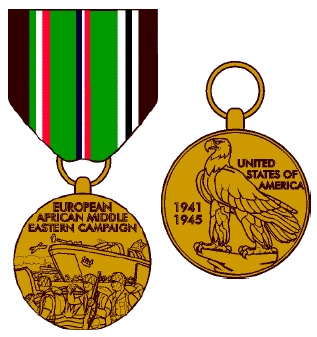
DESCRIPTION: The Bronze medal is 1 ¼ inches in width. On the obverse is a LST landing craft and troops landing under fire with an airplane in the background below the words "EUROPEAN AFRICAN MIDDLE EASTERN CAMPAIGN". On the reverse, an American bald eagle close between the dates "1941 - 1945" and the words "UNITED STATES OF AMERICA".
RIBBON: The ribbon is 1 3/8 inches wide and consists of the following stripes: 3/16 inch Brown 67136; 1/16 inch Irish Green 67189; 1/16 inch White 67101; 1/16 inch Scarlet 67111; ¼ inch Irish Green; center 1/8 inch triparted Old Glory Blue 67178, White and Scarlet; ¼ inch Irish Green; 1/16 inch White; 1/16 inch Black 67138; 1/16 inch White; and 3/16 inch Brown.
CRITERIA:
a. The European-African-Middle Eastern (EAME) Campaign Medal was awarded to personnel for service within the European-African-Middle Eastern Theater between 7 December 1941 and 8 November 1945 under any of the following conditions:
(1) On permanent assignment.
(2) In a passenger status or on temporary duty for 30 consecutive days or 60 days not consecutive.
(3) In active combat against the enemy and was awarded a combat decoration or furnished a certificate by the commanding general of a corps, higher unit, or independent force that he actually participated in combat.
b. The western boundary of EAME Theater is from the North Pole, south along the 75th meridian west longitude to the 77th parallel north latitude, then southeast through Davis Strait to the intersection of the 40th parallel north latitude and the 35th meridian west longitude, then south along the meridian to the 10th parallel north latitude, then southeast to the intersection of the Equator and the 20th meridian west longitude, then along the 20th meridian west longitude to the South Pole. The eastern boundary of the EAME Theater is from the North Pole south along the 60th meridian east longitude to its intersection with the east boundary of Iran, then south along the Iran boundary to the Gulf of Oman and the intersection of the 60th meridian east longitude, then south along the 60th meridian east longitude to the South Pole. The EAME Theater included Europe, European Russia, Greenland, Iceland, Africa, Iran, Iraq, and Turkey.
COMPONENTS: The following are authorized components:
a. Medal (regular size): MIL-DTL-3943/248. Medal set with full size medal and ribbon bar. NSN 8455-00-269-5768.
b. Medal (miniature): MIL-DTL-3943/248. Available commercially.
c. Ribbon: MIL-DTL-11589/57. NSN 8455-00-257-0537. Available commercially.
d. Streamer: The EAME Campaign ribbon is used as a streamer for 16 streamers on the Army flag. Units that receive campaign credit display the streamers for the applicable campaigns in which they participated.
BACKGROUND:
a. The EAME Campaign Medal was established per Executive Order 9265, dated 6 November 1942, by President Franklin D. Roosevelt and announced in War Department Bulletin 56, 1942. The criteria was initially announced in Department of the Army (DA) Circular 84, dated 25 March 1948, and subsequently published in Army Regulation 600-65, dated 22 September 1948.
b. The ribbon design was approved by the Secretary of War in December 1942. The brown represents the sands of Africa and the green represents the green fields of Europe. The center blue, white, and red stripes are taken from the American Defense Service Medal ribbon and refers to the continuance of American Defense after Pearl Harbor. Green, white and red are the Italian colors and the white and black colors represent Germany.
c. The medal was designed by Mr. Thomas Hudson Jones, based on General Eisenhower’s request that the medal include an invasion scene. The reverse side was designed by Mr. A. A. Weinman and is the same design as used on the reverse of the Asiatic-Pacific and American Campaign Medals. The medal design was submitted to the Commission of Fine Arts on 17 September 1946 and the first sample was completed in July 1947. General Eisenhower was presented the first medal on 24 July 1947.
d. A bronze star is worn on the ribbon to indicate participation in designated campaigns. The designated campaigns for the European-African-Middle Eastern Theater are:
Egypt-Libya 11 Jun 42 - 12 Feb 43
Air Offensive, Europe 4 Jul 42 - 5 Jun 44
Algeria-French Morocco 8-11 Nov 42
Tunisia 12 Nov 42 - 13 May 43
Sicily 14 May 43 - 17 Aug 43
Naples-Foggia 18 Aug 43 - 21 Jan 44
Anzio 22 Jan 44 - 24 May 44
Rome-Arno 22 Jan 44 - 9 Sep 44
Normandy 6 Jun 44 - 24 Jul 44
Northern France 25 Jul 44 - 14 Sep 44
Southern France 15 Aug 44 - 14 Sep 44
Northern Apennines 10 Sep 44 - 4 Apr 45
Rhineland 15 Sep 44 - 21 Mar 45
Ardennes-Alsace 16 Dec 44 - 25 Jan 45
Central Europe 22 Mar 45 - 11 May 45
Po Valley 5 Apr 45 - 8 May 45
* Antisubmarine 7 Dec 41 - 2 Sep 45
* Ground Combat 7 Dec 41 - 2 Sep 45
* Air Combat: 7 Dec 41 - 2 Sep 45
* These campaigns are not displayed as streamers on the Army flag.
e. A bronze arrowhead is worn on the ribbon to indicate participation in a combat parachute jump, combat glider landing, or amphibious assault landing within the EAME Theater.
World War II Victory Medal
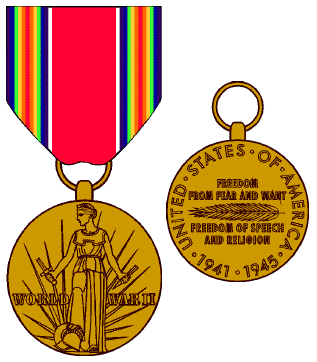
DESCRIPTION: The Bronze medal is 1 3/8 inches in width. On the obverse is a figure of Liberation standing full length with head turned to dexter looking to the dawn of a new day, right foot resting on a war god’s helmet with the hilt of a broken sword in the right hand and the broken blade in the left hand, the inscription "WORLD WAR II" placed immediately below the center. On the reverse are the inscriptions "FREEDOM FROM FEAR AND WANT" and "FREEDOM OF SPEECH AND RELIGION" separated by a palm branch, all within a circle composed of the words "UNITED STATES OF AMERICA 1941 1945".
RIBBON: The ribbon is 1 3/8 inches wide and consists of the following stripes: 3/8 inch double rainbow in juxtaposition (blues, greens, yellows, reds (center), yellows greens and blues); 1/32 inch White 67101; center 9/16 inch Old Glory Red 67156; 1/32 inch White; and 3/8 inch double rainbow in juxtaposition. The rainbow on each side of the ribbon is a miniature of the pattern used in the WWI Victory Medal.
CRITERIA:The WW II Victory Medal was awarded to all military personnel for service between 7 December 1941 and 31 December 1946.
COMPONENTS:The following are authorized components and related items:
a. Medal (regular size): MIL-DTL-3943/237. Medal set with full size medal and ribbon bar. NSN 8455-00-269-5782.
b. Medal (miniature): MIL-DTL-3943/237. Available commercially.
c. Ribbon: MIL-DTL-11589/149. NSN 8455-00-257-0577. Available commercially.
d. Streamer: The WW II Victory Medal ribbon is not used as a streamer by the Army. The Navy and Marine Corps does use the ribbon design for a streamer.
BACKGROUND:
a. The World War II Victory Medal was established by an Act of Congress on 6 July 1945 (Public Law 135, 79th Congress) and promulgated by Section V, War Department Bulletin 12, 1945.
b. The medal was designed by Mr. Thomas H. Jones and approved by the Secretary of War on 5 February 1946.
c. The Congressional authorization for the World War II Victory Medal included members of the Armed Forces of the Government of the Philippine Islands. It also specified the ending date would be the date of the termination of hostilities as proclaimed by the President. President Truman officially ended the state of hostilities on 31 December 1946.
Army Of Occupation Medal WWII
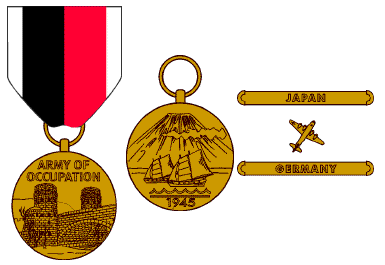
DESCRIPTION: The Bronze medal is 1 ¼ inches in width. On the obverse, the Remagen Bridge abutments below the words "ARMY OF OCCUPATION". On the reverse, Fujiyama with a low hanging cloud over two Japanese junks above a wave scroll and the date "1945". A Bronze clasp 1/8 inch wide and 1 ½ inches in length with the word "GERMANY" or "JAPAN" is worn on the suspension ribbon to indicate service in Europe or the Far East.
RIBBON: The ribbon is the same for both medals and is 1 3/8 inches wide and consists of the following stripes: 3/16 inch White 67101; ½ inch Black 67138; ½ inch Scarlet 67111; and 3/16 inch White.
CRITERIA:
The medal was awarded for 30 days consecutive service while assigned to:
a. Germany (excluding Berlin) between 9 May 1945 and 5 May 1955. Service between 9 May and 8 November 1945 will count only if the EAME Campaign Medal was awarded for service prior to 9 May 1945.
b. Austria between 9 May 1945 and 27 July 1955. Service between 9 May and 18 November 1945 will count only if the EAME Campaign Medal was awarded for service prior to 9 May 1945.
c. Berlin between 9 May 1945 and 2 October 1990. Service between 9 May and 8 November 1945 may be counted only if the EAME Campaign Medal was awarded for service prior to 9 May 1945.
d. Italy between 9 May 1945 and 15 September 1947 in the compartment of Venezia Giulia E. Zara or Province of Udine, or with a unit in Italy designated in DA General Order 4, 1947. Service between 9 May and 8 November 1945 may be counted only if the EAME Campaign Medal was awarded for service prior to 9 May 1945.
e. Japan between 3 September 1945 and 27 April 1952 in the four main islands of Hokkaido, Honshu, Shikoku and Kyushu; the surrounding smaller islands of the Japanese homeland; the Ryukyu Islands; and the Bonin-Volcano Islands. Service between 3 September 1945 and 2 March 1946 will be counted only if the Asiatic-Pacific Campaign Medal was awarded for service prior to 3 September 1945.
f. Korea between 3 September 1945 and 29 June 1949. Service between 3 September 1945 and 2 March 1946 will be counted only if the Asiatic-Pacific Campaign Medal was awarded for service prior to 3 September 1945.
COMPONENTS: The following are authorized components:
a. Army Medal (regular size): MIL-DTL-3943/246. Medal set with full size medal and ribbon bar. NSN 8455-00-269-5763.
b. Army Medal (miniature): MIL-DTL-3943/246. Available commercially.
c. Ribbon: MIL-DTL-11589/112. NSN 8455-00-265-4910. Available commercially.
d. Foreign Service Clasp: MIL-DTL-41819/9: Germany - NSN 8455-00-249-0171; Japan - NSN 8455-00-249-0172.
e. Berlin Airlift Device: MIL-DTL-41819/13. Regular and miniature sizes. NSN 8455-00-261-4504.
BACKGROUND:
a. The Army Occupation Medal was established by War Department Circular 102, dated 5 April 1946.
b. The medal was designed by Mr. Thomas Hudson Jones and the first medal was presented to General Eisenhower on 2 April 1947. The ribbon design uses the color black to represent Germany and the color red to represent Japan.
c. On 4 February 1948, the Secretary of the Navy requested the Heraldic Section, Department of the Army, design a suitable Navy Occupation Service Medal. This medal was designed by Mr. Thomas Hudson Jones on 30 March 1948.
d. The service clasp is worn on the suspension ribbon to indicate area of occupation. The Berlin Airlift Device is a miniature of a C-54 type aircraft and is worn on the suspension ribbon and service ribbon to indicate 90 days consecutive service between 26 June 1948 and 30 September 1949.
Medal For Humane Action
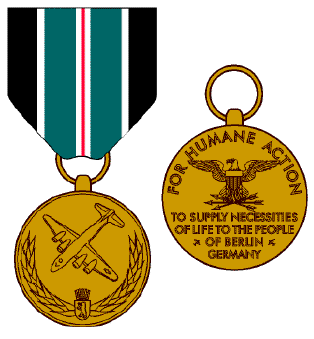
DESCRIPTION: Description: The Bronze medal is 1 ¼ inches in diameter. The miniature medal is 5/8 inch in diameter. On the obverse, in the center, a C-54 airplane (as viewed from above) within a wreath of wheat connected at the bottom by a coat of arms. On the reverse, an eagle, shield and arrows from the seal of the Department of Defense, beneath the words "FOR HUMANE ACTION" and above the inscription in four lines, "TO SUPPLY NECESSITIES OF LIFE TO THE PEOPLE OF BERLIN GERMANY".
RIBBON: The ribbon to the Medal for Humane Action is 1 3/8 inches in width and consists of the following stripes: 9/32 inch black; 1/16 inch white; 9/32 inch teal blue; 3/64 inch white; 1/32 inch scarlet; 3/64 inch white; 9/32 inch teal blue; 1/16 inch white; and 9/32 inch black.
CRITERIA:
a. The Medal for Humane Action was awarded for qualifying service between 26 June 1948 and 30 September 1949.
b. The medal commemorates military service in direct support of the Berlin Airlift. It was awarded to members of the Armed Forces for 120 consecutive days of service in, or in direct support of, the Berlin airlift, between 26 June 1948 and 30 September 1949, within the following prescribed boundaries:
(1) Northern Boundary - 54th parallel north latitude.
(2) Eastern Boundary - 14th meridian east longitude.
(3) Southern Boundary - 48th parallel north latitude.
(4) Western Boundary - 5th meridian west longitude.
COMPONENTS: The following are authorized components:
a. Medal (regular and miniature sizes): MIL-DTL-3943/232.
b. Ribbon (regular and miniature sizes): MIL-DTL-11589/85E
BACKGROUND:
a. The Medal for Humane Action was established by an Act of Congress (Public Law 178, 81st Congress), 20 July 1949.
b. The medal was designed by Mr. Thomas Hudson Jones of The Institute of Heraldry.
c. The C-54 is the type of aircraft used in support of the Berlin airlift, and the coat of arms is that of the City of Berlin. The wreath of wheat represents the staff of life and thereby the necessities of life alluded to on the reverse of the medal.
National Defense Service Medal
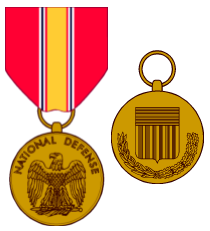
DESCRIPTION: On a Bronze medal, 1 ¼ inches in diameter, an eagle displayed with inverted wings standing on a sword and palm branch, all beneath the inscription "NATIONAL DEFENSE". On the reverse is a shield taken from the Coat of Arms of the United States with an open wreath below it, the right side of oak leaves and the left side of laurel leaves.
RIBBON:: The ribbon is 1 3/8 inches wide and consists of the following stripes: 7/16 inch Scarlet 67111; 1/32 inch White 67101; 1/32 inch Old Glory Blue 67178; 1/32 inch White; 1/32 inch Scarlet; center ¼ inch Golden Yellow 67104; 1/32 inch Scarlet; 1/32 inch White; 1/32 inch Old Glory Blue; 1/32 inch White; and 7/16 inch Scarlet.
CRITERIA:
a. The National Defense Service Medal was awarded for honorable active service for any period between 27 June 1950 and 27 July 1954, between 1 January 1961 and 14 August 1974, and between 2 August 1990 and 30 November 1995, and from 11 September 2001 to a date to be determined. For the purpose of the award, the following persons will not be considered as performing active service:
(1) Guard and Reserve forces personnel on short tours of duty to fulfill training obligations under an inactive duty training program.
(2) Any person on active duty for the sole purpose of undergoing a physical examination.
(3) Any person on temporary active duty to serve on boards, courts, commissions and like organizations or on active duty for purposes other than extended active duty.
b. The National Defense Service Medal may be awarded to members of the Reserve Components who are ordered to Federal active duty, regardless of duration, except for the categories listed above. Any member of the Guard or Reserve who, after 31 December 1960, becomes eligible for the Armed Forces Expeditionary Medal, Vietnam Service Medal or the Southwest Asia Service Medal is also eligible for the National Defense Service Medal.
COMPONENTS: The following are authorized components:
a. Medal (regular size): MIL-DTL-3943/234. NSN 8455-00-281-3214 for set which includes regular size medal and ribbon bar.
b. Medal (miniature size): MIL-DTL-3943/234. Available commercially from certified manufacturers.
c. Ribbon: MIL-DTL-11589/97. NSN 8455-00-264-1478.
d. Lapel Button: MIL-DTL-11484/185. Available commercially.
BACKGROUND:
a. The National Defense Service Medal (NDSM) was established by President Eisenhower per Executive Order 10448, dated 22 April 1953, for service between 27 June 1950 and a date to be announced. On 17 June 1954, the Chief of Staff approved establishment of 27 July 1954 as the termination date for award of the NDSM. Executive Order 11265, dated 11 January 1966, amended Executive Order 10488, to include a termination date and authorized the Secretary of Defense to establish periods of eligibility subsequent to 31 December 1960. Eligibility for award, commencing with the period after 31 December 1960, was established by DOD Directive 1348.7, dated 1 April 1966, and terminated effective 15 August 1974, per letter from Manpower and Reserve Affairs, subject: Termination of Eligibility for the National Defense Service Medal, dated 30 June 1974. The NDSM was again authorized by memorandum, dated 20 February 1991, from Secretary of Defense Cheney for active service on or after 2 August 1990 with no termination date established. The termination date was later established as 30 November 1995.
b. The Heraldic Division, Quartermaster General’s Office, was requested to provide proposed designs for the NDSM and designs created by Mr. T. H. Jones were submitted to the G1 on 26 May 1953. A committee appointed by DOD, which included representatives of all services, met on 27 May 1953 and 3 June 1953 and selected the design for final approval. The eagle, our National emblem, together with the shield of the Coat of Arms of the United States is used to symbolize the defense of the United States. The combination of oak and palm leaves signify strength and preparedness.
c. Order of precedence and wear policy for medals awarded to Army personnel is contained in AR 670-1. Policy for awards, approving authority and supply of medals is contained in AR 600-8-22.
Korean Service Medal
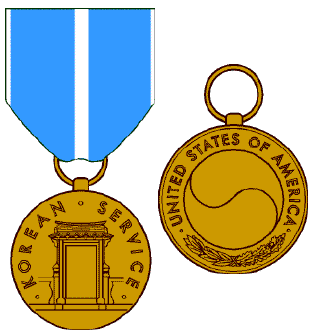
DESCRIPTION: On a Bronze medal, 1 ¼ inches in diameter, a Korean gateway, encircled by the inscription "KOREAN SERVICE". On the reverse is the Korean symbol taken from the center of the Korean National flag with the inscription "UNITED STATES OF AMERICA" and a spray of oak and laurel encircling the design.
Ribbon: The ribbon is 1 3/8 inches wide and consisting of the following stripes: 1/32 inch White 67101; 19/32 inch Bluebird 67117; center 1/8 inch White; 19/32 inch Bluebird; and 1/32 inch White.
CRITERIA:
The Korean Service Medal was awarded for service between 27 June 1950 and 27 July 1954 under and of the following conditions:
a. Within the territorial limits of Korea in waters immediately adjacent thereto: or
b. With a unit under the operational control of the Commander-in-Chief, Far East, other than those units within the territorial limits of Korea, which has been designated by the Commander-in-Chief, Far East, as having directly supported the military efforts in Korea; or
c. Was furnished an individual certificate by the Commander-in-Chief, Far East, testifying to material contribution made in direct support of the military efforts in Korea.
COMPONENTS:The following are authorized components and related items:
a. Medal (regular size): MIL-DTL-3943/223. NSN 8455-00-269-5771 for set which includes regular size medal and ribbon bar.
b. Medal (miniature): MIL-DTL-3946/223. Available commercially.
c. Ribbon: MIL-DTL-11589/78. NSN 8455-00-264-1478.
d. Streamers for units receiving campaign credit - manual requisition in accordance with AR 840-10. The inscription will be as shown on the unit's lineage and honors.
BACKGROUND:
a. The Korean Service Medal was established by President Truman per Executive Order 10179, dated 8 November 1950, and announced in DA Bulletin 21, 1950. The design, created by Mr. Thomas J. Jones, uses the symbols associated with Korea to reflect service in that Country.
b. There were ten campaigns designated for the Korean War and displayed as streamers on the Army flag. The campaign streamers are of the same design as the suspension ribbon for the metal. A bronze star is worn on the ribbon to indicate individual participation for each campaign. The inscriptions on the Army flag streamers are:
UN Defensive 27 Jun - 15 Sep 50
UN Offensive 16 Sep - 2 Nov 50
CCF Intervention 3 Nov 50 - 24 Jan 51
First UN Counteroffensive 25 Jan - 21 Apr 51
CCF Spring Offensive 22 Apr - 8 Jul 51
UN Summer-Fall Offensive 9 Jul - 27 Nov 51
Second Korean Winter 28 Nov 51 - 30 Apr 52
Korean, Summer-Fall 1952 1 May - 30 Nov 52
Third Korean Winter 1 Dec 52 - 30 Apr 53
Korean, Summer 1953 1 May - 27 Jul 53
c. Order of precedence and wear policy for service medals awarded to Army personnel is contained in AR 670-1. Policy for awards, approving authority and supply of medals is contained in AR 600-8-22. Policy for display of campaign streamers on guidons/flags and supply of streamers is contained in Chapter 9, AR 840-10.
Antarctica Service Medal
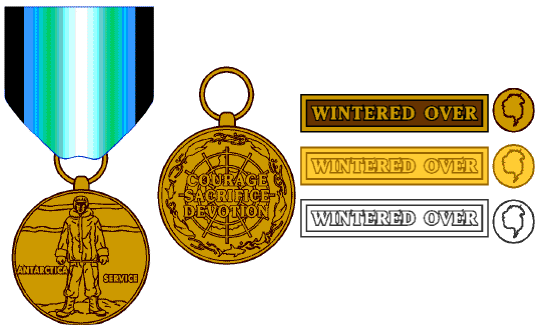
DESCRIPTION:
a. Medal: A Bronze medal, 1 ¼ inches in diameter, with a view of a polar landscape and the standing figure in Antarctica clothing facing to the front between the horizontally placed words "ANTARCTICA" on the figure’s right and "SERVICE" on the figure’s left. On the reverse is a polar projection with geodesic lines of the continent of Antarctica across which are the horizontally placed words "COURAGE", "SACRIFICE", and "DEVOTION", all within a circular decorative border of penguins and marine life.
b. Suspension Ribbon Clasp: On a metal clasp, 1 ¼ inches in width and ¼ inch in height, inscribed with the words "WINTERED OVER" in raised letters within a 1/32 inch rim. The metal color of the clasp is Bronze for the first winter, Gold for the second winter and Silver for the third winter.
c. Service Ribbon Attachment: On a metal disc, 5/16 inch in diameter, a superimposed delineation of the Antarctica continent. The metal color of the ribbon attachment is Bronze for the first winter, Gold for the second winter and Silver for the third winter.
RIBBON: The ribbon is 1 3/8 inches wide and consists of a 3/16 inch Black stripe on each edge and graded from a White stripe in the center to a Pale Blue, Light Blue, Greenish Blue, and Medium Blue.
CRITERIA:
The Antarctica Service Medal is awarded to any person who subsequent to 1 January 1946 meets any of the following criteria:
a. Any member of the Armed Forces of the United States or civilian citizen, national, or resident alien of the United States who participates in or has participated in scientific, direct support, or exploratory operations in Antarctica under sponsorship and approval of the United States Government.
b. Any member of the Armed Forces of the United States who participates in flights as a member of the crew of an aircraft flying to or from the Antarctic Continent in support of operations.
c. Any member of the Armed Forces of the United States or civilian citizen, national, or resident alien of the United States who serves in an United States ship operating south of latitude 60 degrees South in support of United States Programs in Antarctica.
COMPONENTS:: The following are authorized components and related items:
a. Medal (regular size): MIL-DTL-3943/229. NSN 8455-00-965-1708 for full size medal and ribbon bar.
b. Medal (miniature size): MIL-DTL-3943/229. Available commercially.
c. Ribbon: MIL-DTL-11589/11. NSN 8455-00-965-1707. Available commercially.
d. Lapel Button: MIL-L-11484/65. NSN 8455-00-985-7453.
e. Attachments: Wintered Over Clasp: MIL-R-41819/17. Bronze clasp is NSN 8455-00-082-3070, Gold clasp is NSN 8455-00-082-3071, and Silver clasp is NSN 8455-00-082-3072. Miniature clasps are available commercially. The stock numbers for the disc are: Bronze 8455-00-082-3073; Gold 8455-00-082-3074; and Silver 8455-00-082-3075.
BACKGROUND:
a. The Antarctica Service Medal was established by Public Law 86-600 and promulgated in Department of Defense (DOD) Instructions 1348.9 and announced in Department of the Army (DA) Bulletin 3, 1960.
b. The Navy was designated as the lead service for DOD in coordination of the new medal. On 28 November 1960, the Navy requested the Quartermaster General’s Office (The Institute of Heraldry) provide proposed designs and assist in development. Proposed designs were forwarded and the Under Secretary of the Navy approved a design on 17 May 1962. Development was completed and samples provided to the Under Secretary of the Navy on 3 December 1962.
Armed Forces Expeditionary Medal
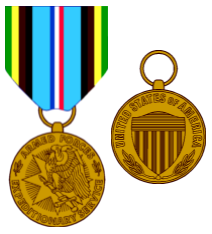
DESCRIPTION: On a Bronze medal, 1 ¼ inches in diameter, an eagle, with wings addorsed and inverted, standing on a sword loosened in its scabbard, and super- imposed on a radiant compass rose of eight points, all within the circumscription "ARMED FORCES" above and "EXPEDITIONARY SERVICE" below with a sprig of laurel on each side. On the reverse is the shield from the United States Coat of Arms above two laurel branches separated by a bullet, all within the circumscription "UNITED STATES OF AMERICA".
RIBBON: The ribbon is 1 3/8 inches wide and consists of the following stripes: 3/32 inch Green 67129; 3/32 inch Golden Yellow 67104; 3/32 inch Spicebrown 67196; 3/32 inch Black 67138; 7/32 inch Bluebird 67117; 1/16 inch Ultramarine Blue 67118; 1/16 inch White 67101; 1/16 inch Scarlet; 7/32 inch Bluebird; 3/32 inch Black; 3/32 inch Spicebrown; 3/32 inch Golden Yellow; and 3/32 inch Green.
CRITERIA:
a. The Armed Forces Expeditionary Medal may be awarded to members of the Armed Forces of the United States who after 1 July 1958 participate as members of U.S. military units in a U.S. military operation in which service members of any Military Department participate, in the opinion of the Joint Chiefs of Staff (JCS), in significant numbers and encounter during such participation foreign armed opposition, or are otherwise place in such a position that in the opinion of the JCS, hostile action by foreign armed forces was imminent even though it does not materialize.
b. The Armed Forces Expeditionary Medal may be authorized for three categories of operations: U.S. military operations; U.S. military operations in direct support of the United Nations; and U.S. operations of assistance to friendly foreign nations.
c. The medal shall be awarded only for operations for which no other U.S. campaign medal is approved.
Components: The following are authorized components and related items:
a. Medal (regular size): MIL-DTL-3943/230. NSN 8455-00-082-5638 for set which includes regular size medal and ribbon bar.
b. Medal (miniature size): MIL-DTL-3946/230. Available commercially.
c. Ribbon: MIL-DTL-11589/12. NSN 8455-00-082-2344.
d. Lapel Button: MIL-DTL-11484. Available commercially.
e. Streamers: MIL-S-14650. Manual requisition in accordance with AR 840-10.
BACKGROUND:
a. During the late 1950’s, it became apparent that a medal was needed to recognize the services of the Armed Forces who participated in the increased involvement of the American military in peacekeeping activities. As a result, President Kennedy established the Armed Forces Expeditionary Medal, per Executive Order 10977, dated 4 December 1961, for operations on or after 1 July 1958.
b. In a memorandum dated 20 December 1961, the Deputy Assistant Secretary of Defense requested that The Institute of Heraldry submit proposed designs as soon as possible. Proposed designs were submitted on 25 January 1962 and a design, created by Mr. Jay Morris, was tentatively selected. The design was submitted to the Commission of Fine Arts for comments prior to approval by the Deputy Secretary of Defense on 24 April 1962.
c. The selected design uses the eagle to represent the strength of our Armed Forces, and the sword, loose in its scabbard, denotes the readiness to serve wherever needed, as further suggested by the compass rose.
d. At the present time, JCS has designated 22 operations for which the Armed Forces Expeditionary Medal may be awarded. A bronze service star is worn to denote second and subsequent awards of the Armed Forces Expeditionary Medal. Each Service may authorize the use of campaign streamers for operations in the designated areas. The Army has authorized campaign credit and display of streamers for three areas: Grenada, Panama and the Dominican Republic. The Air Force has authorized display of streamers for all 22 operations. The Navy authorizes display of three silver stars and four bronze stars on the streamer representing 19 operations.
e. Order of precedence and wear policy for service medals awarded to Army personnel is contained in Army Regulation (AR) 670-1. Policy for awards, approving authority and supply of medals is contained in AR 600-8-22. The policy for display of campaign streamers on guidons/flags and supply of streamers is contained in Chapter 9, AR 840-10
f. The following areas have been designated for award of the Armed Forces Expeditionary Medal:
Lebanon 1 Jul 58 - 1 Nov 58
Quemoy and Matsu Islands 23 Aug 58 - 1 Jun 63
Taiwan Straits 23 Aug 58 - 1 Jan 59
Vietnam 1 Jul 58 - 3 Jul 65
Congo 14 Jul 60 - 1 Sep 62
Laos 19 Apr 61 - 7 Oct 62
Berlin 14 Aug 61 - 1 Jun 63
Cuba 24 Oct 62 - 1 Jun 63
Cambodia 29 Mar 73 - 15 Aug 73
Thailand (Support of Cambodia) 29 Mar 73 - 15 Aug 73
Congo 23 Nov 64 - 27 Nov 64
Dominican Republic 28 Apr 65 - 21 Sep 66
Korea 1 Oct 66 - 30 Jun 74
Cambodia 11 Apr 75 - 13 Apr 75
Vietnam 29 Apr 75 - 30 Apr 75
Mayaguez 15 May 75
Grenada 23 Oct 83 - 21 Nov 83
Lebanon 1 Jun 83 - 1 Dec 87
Libya 12 Apr 86 - 17 Apr 86
Persian Gulf 24 Jul 87 - 1 Aug 90
Panama 20 Dec 89 - 31 Jan 90
Saudi Arabia, Kuwait, Iraq 1 Dec 95 - TBD
Former Republic of Yugoslavia - pending
Vietnam Service Medal
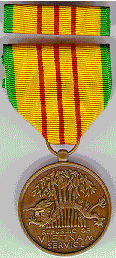
RIBBON: The ribbon is 1 3/8 inches wide and consists of the following stripes: 1/8 inch Primitive Green 67188; 5/16 inch Air Force Yellow 67103; 1/16 inch Old Glory Red 67156; 5/32 inch Air Force Yellow; center 1/16 inch Old Glory Red; 5/32 inch Air Force Yellow; 1/16 inch Old Glory Red; 5/16 inch Air Force Yellow; and 1/8 inch Primitive Green.
CRITERIA:
a. Awarded to all members of the Armed Forces of the United States serving in Vietnam and contiguous waters or airspace thereover, after 3 July 1965 through 28 March 1973. Members of the Armed Forces of the United States in Thailand, Laos, or Cambodia, or the airspace thereover, during the same period and serving in direct support of operations in Vietnam are also eligible for this award. To be eligible for award of the medal, individual must- -
(1) Be attached to or regularly serve for one or more days with an organization participating in or directly supporting military operations; or
(2) Be attached to or regularly serve for one or more days aboard a naval vessel directly supporting military operations; or
(3) Actually participate as a crewmember in one or more aerial flights into airspace above Vietnam and contiguous waters directly supporting military operations; or
(4) Serve on temporary duty for 30 consecutive days or 60 nonconsecutive days in Vietnam or contiguous areas, except that the time limit may be waived for personnel participating in actual combat operations.
b. Individuals qualified for the Armed Forces Expeditionary Medal for service in Vietnam between 1 July 1958 and 3 July 1965 shall remain qualified for the medal. Upon request, the individual may be awarded the Vietnam Service Medal in lieu of the Armed Forces Expeditionary Medal. In such instances, the Armed Forces Expeditionary Medal will be deleted from the list of authorized medals in the individual’s personnel records. No person shall be entitled to both awards for Vietnam Service.
COMPONENTS: The following are authorized components and related items:
a. Medal (regular size): MIL-DTL-3943/230. NSN 8455-00-926-1664 for set which includes a regular size medal and ribbon bar.
b. Medal (miniature size): MIL-DTL-3943/230. Available commercially.
c. Ribbon: MIL-DTL-11589/151. NSN 8455-00-926-1530.
d. Lapel Button (metal replica of ribbon bar): MIL-L-11484/69. Available commercially.
e. Streamer: MIL-S-14650. Manual requisition in accordance with Chapter 9, Army Regulation (AR) 840-10.
BACKGROUND:
a. On 21 August 1964, the Deputy Chief of Staff for Personnel (DCSPER) requested that The Institute of Heraldry provide proposed designs for the possible adoption of a Vietnam Service Medal. Proposed designs were submitted to DCSPER on 29 September 1964. The Vietnam Service Medal was established by Executive Order 11231, dated 8 July 1965. The design approved by the Office of the Secretary of Defense, 12 July 1965, and the policy for award was promulgated by DOD Directive 1348.15, dated 1 October 1965.
b. The design, created by Miss Mercedes Lee, includes bamboo trees which are adapted from the flag of the President of Vietnam and the half-concealed dragon represents the subversive nature of the conflict. The crossbow, on the reverse, is the ancient weapon of Vietnam and the torch of the Statue of Liberty is a symbol of the United States devotion to liberty and freedom. The yellow ribbon with three vertical red stripes suggests the color of the flag of the Republic of Vietnam. The green border on each side alludes to the jungle of that Country.
c. Soldiers receiving the Vietnam Service Medal are authorized to wear a bronze star to indicate each campaign. There are 17 designated campaigns during the period of 15 March 1962 through 28 January 1973. Units which receive campaign credit for any of the campaigns would display a streamer with inscription as shown on the unit's lineage and honors. The designated campaigns are:
Vietnam Advisory 1962-1965
Vietnam Defense 1965
Vietnam Counteroffensive 1965-1966
Vietnam Phase II 1966 - 1967
Vietnam Counteroffensive Phase III 1967-1968
Tet Counteroffensive 1968
Vietnam Counteroffensive Phase IV 1968
Vietnam Counteroffensive Phase V 1968
Vietnam Counteroffensive Phase VI 1968-1969
Tet 69 Counteroffensive 1969
Vietnam Summer-Fall 1969
Vietnam Winter-Spring 1970
Sanctuary Counteroffensive 1970
Vietnam Counteroffensive Phase VII 1970-1971
Consolidation I 1971
Consolidation II 1971-1972
Vietnam Cease-Fire 1972-1973
Southwest Asia Service Medal
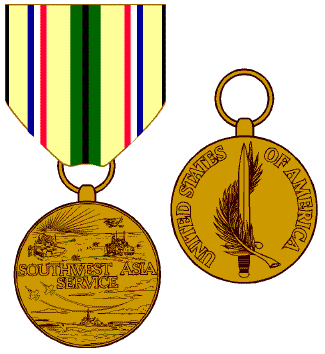
DESCRIPTION: A Bronze medal 1 ¼ inches wide, with the words "SOUTHWEST ASIA SERVICE" across the center background. Above the center is a desert scene with a tank, armored personnel carrier, helicopter and camels with the rising sun in the background. Below the center is a seascape with ship, tanker, aircraft and clouds in the background. On the reverse, is an upraised sword entwined with a palm frond and "UNITED STATES OF AMERICA" around the edge.
Ribbon: The ribbon is 1 3/8 inches wide and consists of the following stripes: 1/16 inch Black 67138; 1/8 inch Chamois 67142; 1/16 inch Old Glory Blue 67178; 1/16 inch White 67101; 1/16 inch Old Glory Red 67156; 3/16 inch Chamois; 3/32 inch Myrtle Green 67190; center 1/16 inch Black; 3/32 inch Myrtle Green; 3/16 inch Chamois; 1/16 inch Old Glory Red; 1/16 inch White; 1/16 inch Old Glory Blue; 1/8 inch Chamois; and 1/16 inch Black.
Criteria:
a. Individuals authorized the Southwest Asia Service Medal must have served in support of Operation Desert Shield or Desert Storm, in one or more of the following areas, between 2 August 1990 and 30 November 1995: Persian Gulf, Red Sea, Gulf of Oman, Gulf of Aden, that portion of the Arabian Sea that lies north of 10 degrees North latitude and west of 68 degrees East longitude, as well as the total land areas of Iraq, Kuwait, Saudi Arabia, Oman, Bahrain, Qatar, and the United Arab Emirates. Individuals serving in Israel, Egypt, Turkey, Syria and Jordan (including the airspace and territorial waters) directly supporting combat operations between 17 January 1991 and 11 April 1991 are also eligible for this award.
b. To be eligible for the award, a service member must be: attached to or regularly serving for one or more days with an organization participating in ground/shore military operations; attached to or regularly serving for one or more days aboard a naval vessel directly supporting military operations; actually participating as a crew member in one or more aerial flights directly supporting military operations in the areas designated; or serving on temporary duty for 30 consecutive days or 60 nonconsecutive days, except, if a waiver is authorized for personnel participating in actual combat.
COMPONENTS: The following are authorized components and related items:
a. Medal (regular size): MIL-DTL-3943/243. NSN 8455-01-334-9513 for set which includes regular size medal and ribbon bar.
b. Medal (miniature size): MIL-DTL-3943/243. Available commercially.
c. Ribbon: MIL-DTL-11589/356. Available commercially.
d. Lapel Button (ribbon replica): MIL-DTL-11484/177. Available commercially.
e. Streamer of the same pattern as the ribbon is authorized for units that received campaign credit participation. The inscription will be as indicated on the unit's lineage and honors.
BACKGROUND:
a. In October 1990, the Deputy Director of Personnel and Administrative Services, Office of the Secretary of Defense (OSD), requested that The Institute of Heraldry provide proposed designs of a service medal for Southwest Asia. Proposed medal designs were forwarded to OSD on 30 October 1990. A proposed Executive Order to authorize the service medal was staffed to the Services, by OSD, on 11 February 1991. President Bush established the Southwest Asia Service Medal by Executive Order 12754, dated 12 March 1991.
b. The medal selected was designed by Miss Nadine Russell and recognizes the joint-service nature of the operation. It depicts a tank, armored personnel carrier, helicopter, ship and aircraft with a desert and seascape. The reverse side symbolized military might and preparedness in defense of peace. The sand colored ribbon with red, white, blue, green and black stripes represented the colors of the United States and the coalition members.
c. Bronze stars are worn on the ribbon to indicate campaign participation by the service member. Three campaigns have been designated - - "DEFENSE OF SAUDI ARABIA" for the period 2 August 1990 through 16 January 1991, "LIBERATION AND DEFENSE OF KUWAIT" for the period 17 January 1991 through 11 April 1991, and "SOUTHWEST ASIA CEASE- FIRE" for the period 12 April 1991 through 30 November 1995.
d. The criteria/policy for the Southwest Asia Service Medal was promulgated by Change No. 1 to DOD 1348-33-M, dated 14 June 1991. This manual established the two campaigns for Southwest Asia. The Joint Chiefs of Staff approved a termination date for the second campaign and established the third campaign per memorandum, dated 3 December 1991, from the Director, Joint Staff, subject: Termination Date for the Second Campaign and Establishment of a Third Campaign for the Southwest Asia Service Medal.
e. Order of precedence and wear policy for service medals awarded to Army personnel is contained in Army Regulation (AR) 670-1. Policy for awards, approving authority and supply of medals is contained in AR 600-8-22. The policy for display of campaign streamers on guidons/flags and supply of streamers is contained in Chapter 9, 840-10.
Kosovo Campaign Medal
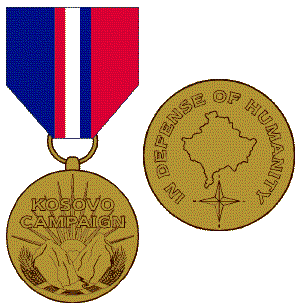
DESCRIPTION: A Bronze medal, 1 3/8 inches in diameter, with the stylized wreath of grain, reflecting the agricultural domination of the area and its economy, symbolizes the basic human rights while highlighting the desire of all for peace, safety and prosperity. The rocky terrain, fertile valley, and mountain pass refer to the Dinartic Alps and the Campaign Theater of operations. The sunrise denotes the dawning of a new age of unity and hope; the right to forge a future of freedom, progress and harmony, thus fulfilling the goal of the Alliance. On the reverse an outline of the Yugoslavian Province of Kosovo, denoting the area of conflict, is combined with a NATO star and highlighted compass cardinal points, signifying the Alliance participants who stabilized the region and provided massive relief. The inscription "IN DEFENSE OF HUMANITY" reinforces the objective of the action.
RIBBON: The ribbon is 1 3/8 inches in width. It is composed of the following vertical stripes: 15/32 inches Old Glory Blue 67178; 7/64 inch Scarlet 67111; 5/32 inch White 67101; 7/64 inch Old Glory Blue 67178; 15/32 inch Scarlet 67111.
CRITERIA: Service Members authorized the Kosovo Campaign Medal must have participated in or served in direct support of Kosovo Operation(s): ALLIED FORCE (24 Mar through Jun 1999); JOINT GUARDIAN (11 Jun 1999 through To Be Determined); ALLIED HARBOUR 4 Apr through 1 Sep 1999); SUSTAIN HOPE/SHINING HOPE (4 Apr through 10 Jul 1999); NOBLE ANVIL (24 Apr through 20 Jul 1999); or Kosovo TASK FORCE (S): HAWK (5 Apr through 24 Jun 1999); SABER (31 Mar through 8 Jul 1999); or HUNTER (1 Apr through 1 Nov 1999) within the Kosovo Air Campaign or Kosovo Defense Campaign areas of eligibility (AOE):
a. Kosovo Air Campaign (24 March 1999 through 10 June 1999) AOE: the total land area and air space of Serbia (including Kosovo), Montenegro, Albania, Macedonia, Bosnia, Croatia, Hungary, Romania, Greece, Bulgaria, Italy and Slovenia; and the waters and air space of the Adriatic and Ionian Sea north of the 39th North latitude.
b. Kosovo Defense Campaign (11 Jun 1999 through To Be Determined) AOE: The total land area and air space of Serbia (including Kosovo), Montenegro, Albania, Macedonia, and the waters and air space of the Adriatic seas within 12 nautical miles of the Montenegro, Albania, and Croatia coastlines South of 42 degrees and 52 minutes North latitude.
CRITERIA: Service members must be bonafide members of a unit participating in or be engaged in direct support of the Operation for 30 consecutive days in the AOE or for 60 nonconsecutive days provided this support involves the entering the Operations AOE or meet one or more of the following criteria:
a. Be engaged in actual combat, or duty that is equally hazardous as combat duty, during the Operation with armed opposition, regardless of time in the AOE.
b. While participating in the Operation, regardless of time, is wounded or injured and required medical evacuation from the AOE.
c. While participating as regularly assigned aircrew member flying sorties into, out of, within, or over the AOE in direct support of the military operations.
NAVAL VESSELS: The Secretary of Defense approved the award to the following Navy vessels as an exception to the 30 consecutive days within the Kosovo Air Campaign AOE criteria: USS Norfolk, USS Miami, USS Bose, USS Albuquerque, USS Nicholson, USS Philippine Sea, and USS Gonzalez.
SERVICE STARS: One Bronze Service Star shall be worn on the suspension and service ribbon of the Kosovo Campaign Medal for qualified participation during campaign period (an individual who participated in one campaign would wear the Medal and/or Service Ribbon with one star). Meeting the qualification in each of the two campaigns would warrant the Medal and two Bronze Service Stars. However, if an individual's 30 or 60 days began in one campaign and carried over into the 2d campaign, they would only qualify for the Kosovo Campaign Medal and one Service Star.
COMPONENTS: The following are authorized components of the Kosovo Campaign Medal.
a. Decoration (regular size): MIL-DTL-3943/269.
b. Decoration (miniature size): MIL-DTL-3943/269.
c. Ribbon: MIL-DTL-11589/532.
d. Lapel Button: MIL-DTL-11484-266.
BACKGROUND:
a. The Kosovo Campaign Medal was established by Executive Order 13154, dated 3 May 2000 to recognize the accomplishments of military service members who participated in or was in direct support of the Kosovo Operations.
b. The Kosovo Campaign Medal will be worn in chronological sequence after the Southwest Asia Service Medal or after the last Service Award. Order of precedence and wear policy for service medals awarded to Army personnel is contained in Army Regulation (AR) 670-1. Policy for awards, approving authority and supply of medals is contained in AR 800-8-22. The policy for display of campaign streamers on guidons/flags and supply of streamers is contained in chapter 8, 840-10.
Afghanistan Campaign Medal
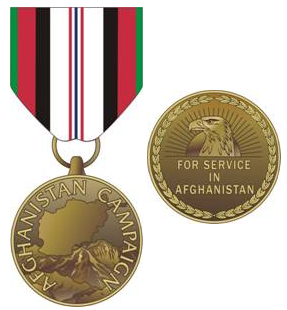
DESCRIPTION: On a bronze metal 1 3/8 inches (3.49 cm) in diameter above a range of mountains is a map of Afghanistan. Around the top is the inscription “AFGHANISTAN CAMPAIGN.” On the reverse, a radiating demi-sun superimposed by an eagle’s head couped. Inscribed across the bottom half of the reserve side are the three lines “FOR SERVICE” “IN” “AFGHANISTAN” all enclosed by a laurel wreath.
SYMBOLISM: Mountains dominate the landscape of Afghanistan. The map of the country highlights the theater of operation and our commitment to Operation Enduring Freedom. The eagle, a symbol of the United States and the American spirit, is constantly vigilant, ready to defend freedom. The rising sun embodies a new start for Afghanistan and its road to a free and prosperous future. The laurel wreath is for honor and high achievement. The ribbon reflects the colors of the new Afghanistan flag and the red, white and blue represent the United States and its allies.
RIBBON: The ribbon is 1 3/8 inches wide and consists of the following stripes: 5/64 inch Emerald 67128; 3/16 inch Scarlet 67111; 1/8 inch Black 67138; 7/32 inch White 67101; 1/32 inch Scarlet 67111; 1/32 inch White 67101; 1/32 inch Old Glory Blue 67178; 1/32 inch White 67101; 1/32 inch Scarlet 67111; 7/32 inch White 67101; 1/8 inch Black 67138; 3/16 inch Scarlet 67111; 5/64 inch Emerald 67128.
CRITERIA:
a. The Afghanistan Campaign Medal is authorized by Public Law 108–234, 28 May 2004, and Executive Order 13363, 29 November 2004, as amended by Executive Order 13289, 12 March 2003.
b. Individuals authorized the Afghanistan Campaign Medal must have served in direct support of Operation ENDURING FREEDOM (OEF). The area of eligibility encompasses all land area of the country of Afghanistan and all air spaces above the land. The Afghanistan Campaign Medal period of eligibility is on or after 24 October 2001 to a future date to be determined by the Secretary of Defense or the cessation of OEF.
c. Service members qualified for the Global War on Terrorism Expeditionary Medal by reasons of service between 24 October 2001 and 28 February 2005, in an area for which the Afghanistan Campaign Medal was subsequently authorized, will remain qualified for that medal. Upon application, any such service member may be awarded the Afghanistan Campaign Medal in lieu of the Global War on Terrorism Expeditionary Medal for such service. No service member will be entitled to both medals for the same act, achievement or period of service.
The qualifying Afghanistan Campaign Medal operations, campaign phases, and associated inclusive dates for each are as follows:
Operations:
· Enduring Freedom (Afghanistan) Sept. 11, 2001 to Dec. 31, 2014.
· Freedom's Sentinel Jan. 1, 2015 to present.
Campaign Phases:
· Liberation of Afghanistan Sept. 11, 2001 to Nov. 30, 2001.
· Consolidation I Dec. 1, 2001 to Sept. 30, 2006.
· Consolidation II Oct. 1, 2006 to Nov. 30, 2009.
· Consolidation III Dec. 1, 2009 to June 30, 2011.
· Transition I July 1, 2011 to Dec. 31, 2014.
· Transition II Jan. 1, 2015 to present.
d. Service members must have been assigned, attached, or mobilized to units operating in the area of eligibility for 30 consecutive days or for 60 non-consecutive days or meet one of the following criteria:
(1) Be engaged in combat during an armed engagement, regardless of the time in the area of eligibility.
(2) While participating in an operation or on official duties, is wounded or injured and requires medical evacuation from the area of eligibility.
(3) While participating as a regularly assigned air crewmember flying sorties into, out of, within or over the area of eligibility in direct support of the military operations; each day of operations counts as one day of eligibility.
e. The following rules apply to award the Afghanistan Campaign Medal:
(1) The Afghanistan Campaign Medal may be awarded posthumously.
(2) Only one award of this medal may be authorized for any individual.
(3) Under no condition will personnel or units receive the Afghanistan Campaign Medal, the Global War on Terrorism Expeditionary Medal, the Global War on Terrorism Service Medal, the Iraq Campaign Medal, or the Armed Forces Expeditionary Medal for the same action, time period or service.
f. Precedence for the Afghanistan Campaign Medal will be positioned below the Kosovo Campaign Medal and above the Iraq Campaign Medal.
COMPONENETS: The following are authorized components and related items:
a. Medal (regular size): MIL-DTL-3943/318B. NSN 8455-01-527-8027 for set which includes regular size medal and ribbon bar.
b. Medal (miniature size): MIL-DTL-3943/318B. Available commercially.
c. Ribbon: MIL-DTL-11589/593. Available commercially.
d. Lapel Button (ribbon replica): MIL-DTL-11484/312. Available commercially.
BACKGROUND:
Public Law 108-234, dated 28 May 2004 and Executive Order 13363, dated 29 November 2004, established the medal. The Office of the Under Secretary of Defense announced the establishment of campaign phases on 19 February 2008.
In order of precedence, the ACM will be worn before the Iraq Campaign Medal (ICM) and shall directly follow the Kosovo Campaign Medal (KCM) (i.e., KCM, ACM, ICM, GWOTEM, etc.).
Order of precedence and wear policy for service medals awarded to Army personnel is contained in Army Regulation (AR) 670-1. Policy for awards, approving authority and supply of medals is contained in AR 600-8-22. The policy for display of campaign streamers on guidons/flags and supply of streamers is contained in Chapter 9, AR 840-10.
Iraq Campaign Medal
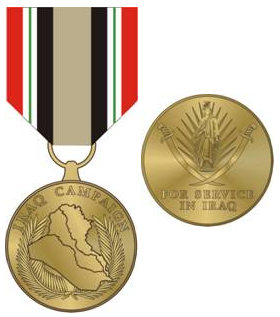
DESCRIPTION: On a bronze metal 1 3/8 inches (3.49 cm) in diameter the relief of Iraq, surmounted by two lines throughout, surmounting a palm wreath. Above is the inscription “IRAQ CAMPAIGN.” On the reverse, the Statue of Freedom surmounting a sunburst, encircled by two scimitars points down crossed at tip of blades, all above the inscription “FOR SERVICE IN IRAQ.”
SYMBOLISM: The relief of Iraq represents the area of operation. The lines symbolize the Tigris and Euphrates Rivers, recalling Iraq’s title as “the land of two rivers.” The palm wreath denotes peace and honor. The Statue of Freedom represents the ideals and goals of the United States army to bring stability and improve the way of life for Iraq. The sunburst symbolizes hope and success. The two scimitars recall the swords erected by Sadam Hussein during his reign; the points down symbolize the goal for freedom of the Iraqi people, after the fall of Hussein. The ribbon reflects the colors of the Iraq flag. Green is the traditional color for Islam. Red honors the fighting courage for the pursuit of freedom. White denotes generosity and black exemplifies Islam’s success.
RIBBON: The ribbon is 1 3/8 inches wide and consists of the following stripes: 5/32 inch Scarlet 67111; 1/16 inch White 67101; 1/32 inch Green 67129; 1/16 inch White 67101; 5/32 inch Black 67138; 7/16 inch Chamois 67142; 5/32 inch Black 67138; 1/16 inch White 67101; 1/32 inch Green 67129; 1/16 inch White 67101; 5/32 inch Scarlet 67111.
CRITERIA:
a. Authorized to be awarded to soldiers who deploy to Iraq in direct support of Operation Iraqi Freedom (OIF) on or after 19 March 2003 to 31 December 2011. The area of eligibility encompasses all land area of the country of Iraq and the contiguous water area out to 12 nautical miles, and all air spaces above the land area of Iraq and above the contiguous water area out to 12 nautical miles.
b. To be eligible for the award, a soldier must be assigned or attached to a unit participating in OIF for 30 consecutive days or for 60 nonconsecutive days in Iraq or meet one of the following criteria: 1) Be engaged in actual combat against the enemy and under circumstances involving grave danger of death or serious bodily injury from enemy action, regardless, of time in the Iraq. 2) While participating in OIF or on official duties, regardless of time, is killed or wounded/injured requiring medical evacuation from Iraq. 3) While participating as a regularly assigned air crew member flying sorties into, out of, within, or over Iraq in direct support of OIF; each day that one or more sorties are flown in accordance with the criteria shall count as one day towards the 30 consecutive or 60 nonconsecutive day requirement.
c. The medal may be awarded posthumously to any soldier who lost his/her life while, or as a direct result of, participating in qualifying operations, without regard to length of such service, if otherwise eligible.
d. This medal must have at least 1 bronze service star, check period of service in theater as follows:
19 Mar 2003 - 01 May 2003
02 May 2003 - 28 Jun 2004
29 Jun 2004 - 15 Dec 2005
16 Dec 2005 - 09 Jan 2007
10 Jan 2007 - 31 Dec 2008
01 Jan 2009 – 31 Dec 2011
Reference: MilPer Message 08-123, dated 14 May 2012.
e. Service members qualified for the Global War on Terrorism Expeditionary Medal (GWOTEM) by reasons of service between 19 March 2003 and 30 April 2005, in Iraq, shall remain qualified for the medal. Any such soldier may be awarded the ICM in lieu of the GWOTEM for such service. Additionally, any such soldier authorized the arrowhead device may be awarded the ICM with arrowhead device in lieu of the GWOTEM with arrowhead device. No soldier shall be entitled to both medals for the same act, achievement or period of service.
COMPONENTS: The following are authorized components and related items:
a. Medal (regular size): MIL-DTL-3943/319. NSN 8455-01-527-8023 for set which includes regular size medal and ribbon bar.
b. Medal (miniature size): MIL-DTL-3943/319. Available commercially.
c. Ribbon: MIL-DTL-11589/594. Available commercially.
d. Lapel Button (ribbon replica): MIL-DTL-11484/313. Available commercially.
BACKGROUND:
a. Public Law 108-234, dated 28 May 2004 and Executive Order 13363, dated 29 November 2004, established the medal.
b. In order of precedence, the ICM will be worn before the Global War On Terrorism Medal (GWOTEM) and shall directly follow the Afghanistan Campaign Medal (ACM) (i.e., KCM, ACM, ICM, GWOTEM, etc.).
c. Order of precedence and wear policy for service medals awarded to Army personnel is contained in Army Regulation (AR) 670-1. Policy for awards, approving authority and supply of medals is contained in AR 600-8-22. The policy for display of campaign streamers on guidons/flags and supply of streamers is contained in Chapter 9, AR 840-10.
Global War On Terrorism Expeditionary Medal (GWOTEM)
.png?sfvrsn=722bf08d_0)
The GWOTEM was established by Executive Order 13289, 12 March 2003. It is authorized for award to members of the Armed Forces of the United States who deployed abroad for service in the GWOT Operations on or after 11 September, 2001 to a date to be determined. Operations approved the GWOTEM are provided in MILPER Message 09-026 also outlined in a below.
a. Initial award of the GWOTEM. Limited to Servicemembers deployed abroad in support of OEF, OIF, and OND in the following designated specific geographic AOE: Afghanistan, Algeria, Azerbaijan, Bahrain, Bosnia-Herzegovina, Bulgaria (Bourgas), Burkina Faso, Chad, Columbia, Crete, Cyprus, Diego Garcia, Djibouti, Egypt, Eritrea, Ethiopia, Georgia, Guantanamo Bay (Cuba), Hungary, Iran, Iraq, Israel, Jordan, Kazakhstan, Kenya, Kosovo (only specific GWOT operations not associated with operations qualifying for the KCM), Kuwait, Kyrgyzstan, Lebanon, Mali, Mauritania, Morocco, Niger, Nigeria, Oman, Pakistan, Philippines, Qatar, Romania (Constanta), Saudi Arabia, Senegal, Sierra Leone, Somalia, Syria, Tajikistan, Tanzania, Tunisia, Turkey, Turkmenistan, Uganda, United Arab Emirates, Uzbekistan, Yemen, that portion of the Arabian Sea north of 10 degrees north latitude and west of 68 degrees longitude, Bab El Mandeb, Gulf of Aden, Gulf of Aqaba, Gulf of Oman, Gulf of Suez, that portion of the Mediterranean Sea east of 28 degrees east longitude and boarding and searching vessel operations, Persian Gulf, Red Sea, Strait of Hormuz, and Suez Canal.
b. Effective 30 April 2005, the GWOTEM is no longer authorized to be awarded for service in Afghanistan and/or Iraq. Soldiers are only authorized award of the ACM and ICM after this date. The GWOTEM is authorized for direct support deployments, such as Kuwait or Qatar. See list above.
c. Servicemembers must be assigned, attached or mobilized to a unit participating in designated operations for 30 consecutive days or 60 nonconsecutive days in the AOE, or meet one of the following criteria: (1) Be engaged in actual combat against the enemy and under circumstances involving grave danger of death or serious bodily injury from enemy action, regardless of time in the AOE. (2) While participating in the designated operation, regardless of time, is killed, wounded or injured requiring medical evacuation from the AOE. (3) Servicemembers participating as a regularly assigned air crew member flying sorties into, out of, within, or over the AOE in direct support of ONS, OEF, OIF, or OND are eligible to qualify for award of the GWOTEM. Each day that one or more sorties are flown in accordance with these criteria will count as one day toward the 30 consecutive or 60 nonconsecutive day requirement.
d. The GWOTEM will not be awarded to Soldiers who are deployed/mobilized to an AOE for the purpose of staging operations, with follow on movement into Iraq or Afghanistan in support of Operation Nomad Shadow (ONS), OIF, OEF, and OND.
e. Servicemembers qualified for the GWOTEM by reasons of service before 30 April 2005, in Afghanistan and Iraq, shall remain qualified for the medal. Any such Soldier may be awarded the ACM or the ICM in lieu of the GWOTEM for such service. Additionally, any such Soldier authorized the arrowhead device may be awarded the ACM or ICM with arrowhead in lieu of the GWOTEM with arrowhead device. Soldiers that elect to receive the GWOTEM in lieu of the ACM or ICM are not authorized service stars for those campaigns in which the GWOTEM is awarded. No Soldier shall be entitled to both medals for the same act, achievement, or period of service.
f. On 31 October 2014, the Under Secretary of Defense, Personnel and Readiness approved the GWOTEM for Operation INHERENT RESOLVE for the period beginning on 15 June 2014, and ending on a date to be determined for the following locations: Bahrain, Cyprus, Egypt, Iran, Iraq, Israel, Jordan, Kuwait, Lebanon, Qatar, Saudi Arabia, Syria, Turkey, United Arab Emirates, the Mediterranean Sea east of 25 degrees longititude, the Persian Gulf, and the Red Sea. Soldiers must be deployed abroad to one of these designated areas to qualify for the GWOTEM. Currently, there are no battle stars or service stars authorized with the GWOTEM.
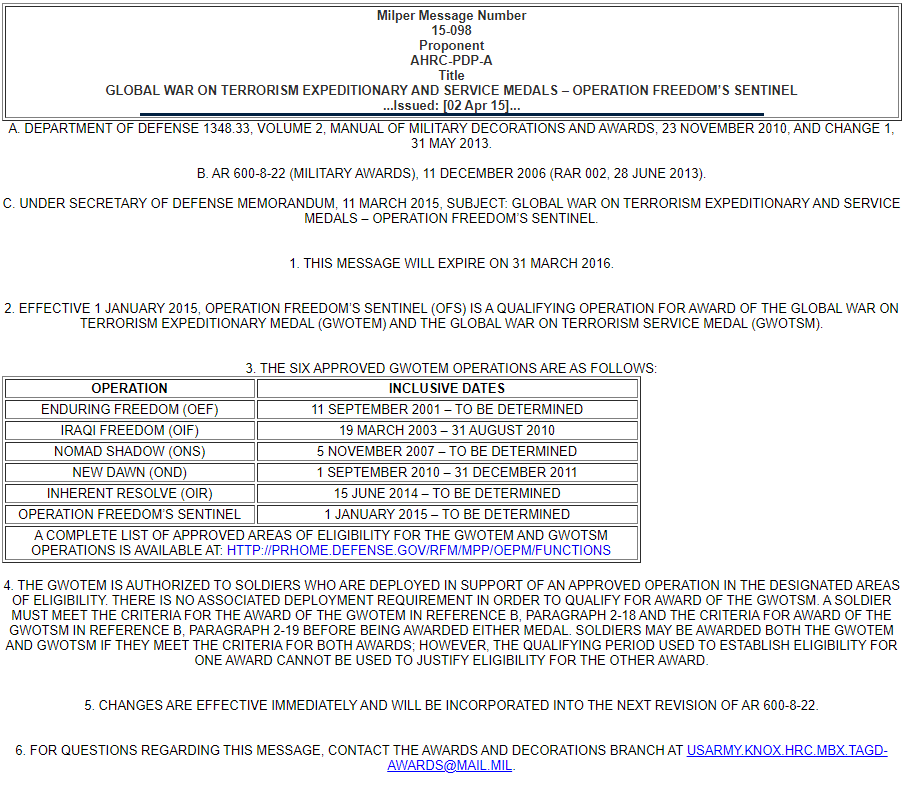
Global War On Terrorism Service Medal (GWOTSM)
.png?sfvrsn=75e2ccf1_0)
The Global War on Terrorism Service Medal (GWOTSM) was established by Executive Order 13289, 12 March 2003. It is authorized for award to members of the Armed Forces of the United States who have participated in the Global War on Terrorism (GWOT) operations outside of the designated areas of eligibility (AOE) for the GWOTEM (see GWOTEM Q&A), on or after 11 September 2001 to a future date to be determined. Battalion commanders and commanders of separate units have the authority to award the GWOTSM for approved operations to units and personnel within his or her command. Service members must be assigned, attached, or mobilized to a unit supporting designated operations for 30 consecutive days or for 60 nonconsecutive days, or meet one of the following criteria:
a. Initial award of the GWOTSM. Limited to airport security operations (from 27 September 2001 through 31 May 2002) and Soldiers who supported Operations NOBLE EAGLE, ENDURING FREEDOM (OEF), IRAQI FREEDOM (OIF), and NEW DAWN (OND).
b. All Soldiers on active duty, including Reserve Component Soldiers mobilized, or National Guard Soldiers activated on or after 11 September 2001 to a date to be determined having served 30 consecutive days or 60 nonconsecutive days (outside of the AOE for the GWOTEM, refer to MILPER Message 09-026) are authorized the GWOTSM.
c. Service members may be awarded both the GWOTEM and the GWOTSM if they meet the criteria for both awards; however, the qualifying period used to establish eligibility for one award cannot be used to justify eligibility for the other award. The GWOTSM will be worn after the GWOTEM and both will directly follow the Kosovo Campaign Medal (KCM) (that is, KCM, GWOTEM, GWOTSM, Korean Defense Service Medal (KDSM), and so forth.)
d. Subsequent awards. Only one award of the GWOTSM may be authorized to any individual; therefore, second and subsequent awards will not be awarded.

Korea Defense Service Medal
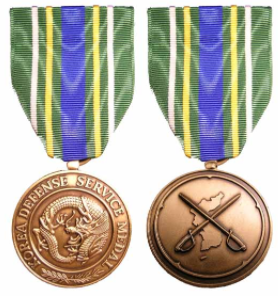
DESCRIPTION:
OBVERSE
In the center of a bronze disc, a "circle dragon" surrounded by the words KOREA DEFENSE SERVICE MEDAL. At the bottom of the medal, and following its lower contour, are a spray of laurel on the left and a spray of bamboo on the right, joined at the center.
The four-clawed dragon is a traditional symbol of Korea and represents intelligence and strength of purpose. The laurel denotes honorable endeavor and victory, and the bamboo alludes to Asia.
REVERSE
In the center of the medal a representation of the land mass of Korea is surmounted by two swords, points up, saltirewise (crossed). The central theme is surrounded by a circlet with five inward points. The swords signify defense of freedom in Korea and the readiness to engage in combat towards that end. The circlet enclosing the central theme recalls the forms of five-petal symbols common in Korean armory. A Bronze medal, 1 1/4 inches in diameter with a demi-torch (as on the Statue of Liberty) encircled at the top by the inscription "ARMED FORCES SERVICE MEDAL" on the obverse side. On the reverse side is an eagle (as on the seal of the Department of Defense) between a wreath of laurel in base and the inscription "IN PURSUIT OF DEMOCRACY" at the top.
RIBBON: The ribbon is a field of dark green bisected in the center by a stripe of dark blue. There are white and gold pinstripes to either side of the dark blue, but separated from it by dark green. The white and gold pinstripes are themselves separated by dark green. The dark green represents the land of Korea; the blue indicates overseas service and commitment to achieving peace. The gold denotes excellence, while the white stands for idealism and integrity.
Criteria:
This medal is awarded to members of the Armed Forces of the United States who have been assigned, attached, or mobilized to units operating in the area of eligibility for thirty consecutive or for sixty non-consecutive days, or who meet the following criteria:
-- Be engaged in combat during an armed engagement, regardless of the time in the area of elibility;
-- Is wounded or injured in the line of duty and requires medical evacuation from the area of eligibility;
-- While participating as a regularly assigned aircrew member flying sorties into, out of, or within the area of eligibility in direct support of military operations. Each day that one or more sorties are flown in accordance with these criteria shall count as one day toward the 30 or 60 day requirement;
-- Personnel who serve in operations and exercises conducted in the area of eligibility are considered for the award as long as the basic time criteria are met. Due to the extensive time period for KDSM eligibility, the non-consecutive service period for eligibility remains cumulative throughout the entire period.
The Area of eligibility encompasses all land area of the Republic of Korea, and the continuous water out to 12 nautical miles, and all air spaces above the land and water areas.
BACKGROUND:
a. The Korea Defense Service Medal was established by Section 543 of the 2003 National Defense Authorization Act (PL 107-314) signed into law by President George W. Bush on December 2, 2002.
b. The Korea Defense Service Medal is awarded for qualifying service on or after July 28, 1954.
c. The Korean Defense Service Medal is worn after the Global War on Terrorism Service Medal and before the Armed Forces Service Medal.
d. No devices are authorized for this medal: only one award of the KDSM is authorized for any individual.
Armed Forces Service Medal
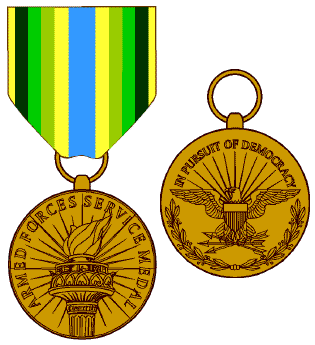
DESCRIPTION: A Bronze medal, 1 1/4 inches in diameter with a demi-torch (as on the Statue of Liberty) encircled at the top by the inscription "ARMED FORCES SERVICE MEDAL" on the obverse side. On the reverse side is an eagle (as on the seal of the Department of Defense) between a wreath of laurel in base and the inscription "IN PURSUIT OF DEMOCRACY" at the top.
RIBBON:The ribbon is 1 3/8 inches wide and consists of the following stripes: 1/16 inch Goldenlight 67107; 1/8 inch Jungle Green 67191; 1/8 inch Green 67129; 1/8 inch Mosstone 67127; 1/8 inch Goldenlight; Center ¼ inch Bluebird 67117; 1/8 inch Goldenlight; 1/8 inch Mosstone; 1/8 inch Green; 1/8 inch Jungle Green; and 1/16 inch Goldenlight.
CRITERIA:
The medal will be awarded to personnel assigned to operations in an area designated by the Department of Defense (DOD) for award of the medal.
COMPONENTSThe following are authorized components and related items:
a. Medal (regular size): MIL-DTL-3943/231. NSN 8455-01-426-5479 for set which includes a regular size medal and ribbon bar.
b. Medal (miniature size): MIL-DTL-3943/231. Available commercially.
c. Ribbon: MIL-DTL-11589/13. Available commercially.
BACKGROUND:
a. On 2 March 1995, the Office of the Assistant Secretary of Defense (Force Management Policy) (OASD-RMP) requested that The Institute of Heraldry prepare a medal and ribbon design for the proposed Armed Forces Service Medal. This medal was to be awarded to members of the Armed Forces who participated as members of units involved in military operations of significant numbers with no foreign armed opposition or the threat of imminent hostile action. This medal is intended to meet a void in the criteria between the Armed Forces Expeditionary Medal and the Humanitarian Service Medal.
b. Proposed design was forwarded by OASD-FMP to the Services and the Joint Staff. Concurrence in the establishment of the medal from the Services and the Joint Staff was received and the proposal was forwarded to the Office of Budget and Management (OMB) for issuance of an Executive Order. The medal was authorized by Executive Order 12985, dated 11 January 1996.
c. Eligibility requirements include:
(1) Service as a member of a unit participating for one or more days in the operation with the designated area of eligibility, or- -
(2) Be engaged in direct support for 30 consecutive days in the area of eligibility (or for the full period when an operation is less than 30 days duration) or for 60 nonconsecutive days provided this support involves entering the area of eligibility, or- -
(3) Participate as a regularly assigned crewmember of an aircraft flying into, out of, within, or over the area of eligibility in support of the operation.
d. The Chairman, Joint Chiefs of Staff (JCS), has approved award of the Armed Forces Service Medal to US Military personnel as follows: (1) In operations relating to the former Republic of Yugoslavia from 1 June 1992 to a future date. This area includes military forces deployed in operations Provide Promise, Joint Endeavor, Able Sentry, Deny Flight, Maritime Monitor, Sharp Guard and Joint Guard within the total land and air space of the former Republic of Yugoslavia, the country of Italy (including Sicily); and the waters and air space above that portion of the Adriatic Sea that lies north of forty degrees North latitude; (2) In operations: United Nations Missions in Haiti (UNMIH); US Forces Haiti (USFORHAITI) and US Support Group-Haiti (USSPTGP-Haiti) from 1 April 1995 to a date to be determined. This area includes the total land area, sea and air space defined by the following coordinates: 16-30N/71-40W; 18-00N/71-45W; along the Haitian/Dominican Republic Border to 20-00N/71-44W; 21-00N/71W; 21-25N/73-00W; 21-25N/74-00W; 20-00N/74-00W; 19-45N/75-00W; 19-00N/76-00W; 16-30N/76-00W; to 16-30N/71-40W.`
NCO Professional Development Ribbon

DESCRIPTION: The ribbon is 1 3/8 inches in width. It is composed of the following vertical stripes: 3/16 inch Green 67129, 1/8 inch Yellow 67108, 3/16 inch Green, 1/16 inch Yellow; 1/4 inch Flag Blue 67124, 1/16 inch Yellow, 3/16 inch Green, 1/8 inch Yellow, and 3/16 inch Green.
COMPONENTS: Ribbon. MIL-D-11589/283. (There is no medal for this ribbon).
CRITERIA:
a. The NCO Professional Development Ribbon is awarded to members of the United States Army, Army National Guard, and Army Reserve for successful completion of designated Noncommissioned Officer professional development courses.
b. A numeral is affixed to the ribbon to indicate completion of specific levels of subsequent courses. Primary level course is indicated by the basic ribbon; basic level course with the number 2; advanced level course with number 3; and senior level course (Sergeants Major Academy) with number 4.
c. Specific criteria for award is contained in AR 600-8-22.
BACKGROUND:
a. The NCO Professional Development Ribbon was established by the Secretary of the Army on April 10, 1981.
b. The colors of the ribbon represent the colors of the chevrons worn by the non-commissioned officer and are on each side of a blue field representing support to the United States.
Army Service Ribbon

DESCRIPTION: The ribbon is 1 3/8 inches in width. It is composed of the following vertical stripes: 7/32 inch Scarlet 67111, 5/32 Orange 67110, 3/32 inch Golden Yellow 67104, 1/8 inch Emerald 67128, Ultramarine Blue 67118, 1/8 inch Emerald, 3/32 inch Golden Yellow, 5/32 inch Orange, and 7/32 inch Scarlet.
COMPONENTS:: Ribbon. MIL-D-11589/281. (There is no medal for this ribbon).
CRITERIA:
a. The Army Service Ribbon is awarded to members of the Army, Army Reserve and Army National Guard for successful completion of initial-entry training.
b. The Army Service Ribbon may be awarded retroactively to those personnel who completed the required training before August 1, 1981 provided they had an active Army status as defined above, on or after August 1, 1981. Only one award is authorized.
c. Officers will be awarded this ribbon upon successful completion of their basic/orientation or higher level course. Enlisted soldiers will be awarded the ribbon upon successful completion of their initial MOS producing course. Officer or Enlisted personnel assigned to a specialty, special skill identifier, or MOS based on civilian or other service acquired skills, will be awarded the ribbon upon honorable completion of four months active service.
BACKGROUND:
a. The Army Service ribbon was established on April 10, 1981, by the Secretary of the Army.
b. The Army Service ribbon is multi-colored to represent the entire spectrum of military specialties in which officers and enlisted soldiers may enter upon completion of their initial training.
Army Overseas Service Ribbon

DESCRIPTION: The Army Overseas Service ribbon is 1 3/8 inches in with. It is composed of the following vertical stripes: 3/16 inch National Flag Blue 67124, 5/16 inch Grotto Blue 67165, 1/16 inch Golden Yellow 67104, 1/4 inch Brick Red 67113, 1/16 inch Golden Yellow, 5/16 inch Grotto Blue, and 3/16 inch National Flag Blue.
COMPONENTS:: Ribbon. MIL-D-11589/282. (There is no medal for this ribbon).
CRITERIA:
a. Effective August 1, 1981, the Army Overseas Service Ribbon is awarded to all members of the Active Army, Army National Guard, and Army Reserve in an active Reserve status for successful completion of overseas tours if the tour is not recognized by the award of a service or campaign medal.
b. The ribbon may be awarded retroactively to personnel who were credited with a normal overseas tour completion before August 1, 1981, provided they had an Active Army status on or after August 1, 1981.
c. Requirements for award of the ribbon are contained in AR 600-8-22.
BACKGROUND:
a. The Army Overseas Service Ribbon was established by the Secretary of the Army on April 10, 1981.
b. Subsequent tours will be indicated by the use of numerals.
Reserve Components Overseas Training Ribbon

RIBBON:The ribbon is 1 3/8 inches in width; however, it is mounted on the ribbon bar horizontally so that the horizontal center stripe is 3/32 inch Old Glory Red with a 3/64 inch White stripe on each side. The remainder of the ribbon is Ultramarine Blue.
CRITERIA:
a. The Army Reserve Components Overseas Training Ribbon is awarded to members of the Army Reserves or Army National Guard for successful completion of annual training or active duty for training for a period of not less than ten consecutive duty days on foreign soil (outside the 50 states, District of Columbia, and U.S. possessions and territories), in the performance of duties in conjunction with Active Army, Joint Services, or Allied Forces. The day of departure counts; however, the day of return does not.
b. The ribbon may be awarded retroactively to personnel who successfully completed annual training or active duty for training on foreign soil in a Reserve status prior to July 11, 1984, provided they have an active status in the Reserve Components on or after July 11, 1984.
COMPONENTS: Ribbon - MIL-DTL-11589/295.
BACKGROUND:
a. The Reserve Components Overseas Training Ribbon was established on July 11, 1984, by the Secretary of the Army.
b. Bronze numerals are used to denote second and subsequent awards of the Reserve Components Overseas Training Ribbon.
c. The Reserve Components Overseas Training Ribbon consists of red, white, and blue and reflects the National colors of the United States of America.
United Nations Service Medal (Korea)
.png?sfvrsn=81c79fb0_0)
:DESCRIPTION:A Bronze medal, 1 3/8 inches in diameter, with a top view of the globe enclosed at sides and bottom by a wreath. The medal has a hanger bar with the inscription "KOREA". On the reverse side of the United Nations Service Medal Korea is the inscription "FOR SERVICE IN DEFENCE OF THE PRINCIPLES OF THE CHARTER OF THE UNITED NATIONS".
RIBBON: Equal stripes of Bluebird 67117 and White 67101 (9 Bluebird and 8 White stripes), each 5/64 inch wide.
WEAR POLICY: Personnel who are awarded the United Nations Medal may wear the first medal and ribbon for which they qualify. Subsequent awards of the United Nations Medal for service in a different mission will be denoted by a bronze service star. Not more than one ribbon may be worn at any time.
Republic Of Vietnam Campaign Ribbon

DESCRIPTION: A Gold six pointed star with rays, 32cm in diameter, superimposed by a White enameled star, 42cm in diameter, overall in center a Green disc, 18cm in diameter, with the outline of the Vietnamese Country with a Red flame of three rays between North and South Vietnam. On the reverse of the medal is a circle with a designation band containing the word "CHIEN-DICH" (Campaign) at the top and "BOI-TINH" (Medal) at the bottom. Across the center of the circle is the word "VIET-NAM".
RIBBON: The ribbon is 1 3/8 inches wide and consists of the following stripes: 1/16 inch Gherkin Green 67183; 3/16 inch White 67101; 5/16 inch Gherkin Green; 1/4 inch White; 5/16 inch Gherkin Green; 3/16 inch White; and 1/16 inch Gherkin Green.
CRITERIA: The Republic of Vietnam Campaign Medal is awarded to personnel who meet one of the following requirements:
a. Served in the Republic of Vietnam for six months during the period of 1 March 1961 and 28 March 1973.
b. Served outside the geographical limits of the Republic of Vietnam and contributed direct combat support to the Republic of Vietnam and Armed Forces for six months. Such individuals must meet the criteria established for the Armed Forces Expeditionary Medal (for Vietnam) or the Vietnam Service Medal, to qualify for the Republic of Vietnam Campaign Medal.
c. Six months service is not required for individuals who were wounded by hostile forces; killed in action or otherwise in line of duty; or captured by hostile forces.
COMPONENTS:: The following are authorized components:
a. Medal (regular size): Available commercially.
b. Medal (miniature size): Available commercially.
c. Ribbon: MIL-R-11589/158. Available commercially.
d. Ribbon Attachment: MIL-R-41819/23. Available commercially.
BACKGROUND:
a. The Secretary of Defense approved a request for approval of foreign awards to US Military personnel on 7 February 1966. As a result of this approval, the Republic of Vietnam Campaign Medal with device bar (1960- ) was awarded to US Armed Forces personnel by the Government of the Republic of Vietnam per Republic of Vietnam Armed Forces Order No. 48, dated 24 March 1966. The acceptance, criteria and description was announced in the Federal Register, Volume 31, No. 147, 30 July 1966 (Title 32, Code of Federal Regulation 47).
b. The Republic of Vietnam Armed Forces Memorandum 2655 prescribed there were two devices to be worn on the ribbon. The first device was for the period 8 March 1949 - 20 July 1954 and is not authorized for wear by American Military Personnel. The second period was from 1 January 1960 with the last period to be decided after the war was over. The ending period remains blank, since the Republic of Vietnam Government ceased to exist before the ending period was established. The devices for the medal are in two sizes - - the large size is 1 13/64 inches in width and is worn on the suspension ribbon of the full size decoration. The regular size is 19/32 inch wide and is worn on the miniature decoration and service ribbon bar.
c. Since the Republic of Vietnam Campaign Medal is a foreign award, it is not issued by the United States Government. The medal may be purchased from commercial sources.
Kuwait Liberation Medal (Government of Saudia Arabia)
.png?sfvrsn=93df214f_0)
DESCRIPTION: The medal is 1 25/32 inches in width and is described as follows: On a Gold sunburst with stylized Silver rays, a globe depicting the Arabian Peninsula encircled by a wreath of palm between a scroll in the base inscribed "LIBERATION OF KUWAIT" and at the top a palm tree issuing from two diagonally crossed sabers, all Gold.
RIBBON: The ribbon is 1 3/8 inches wide and consists of the following stripes: 5/32 inch Old Glory Red 67156; 5/64 inch Black 67138; 9/64 inch White 67101; center 5/8 inch Irish Green 67189; 9/64 inch White; 5/64 inch Black; and 5/32 inch Old Glory Red.
CRITERIA:
a. Members of the Armed Forces of the United States must have served in support of Operation Desert Storm between 17 January 1991 and 28 February 1991 in one of the following areas: Persian Gulf; Red Sea; Gulf of Oman; that portion of the Arabian Sea that lies north of 10 degrees North latitude and west of 68 degrees East longitude; the Gulf of Aden; or the total land areas of Iraq, Kuwait, Saudi Arabia, Oman, Bahrain, Qatar, and the United Arab Emirates.
b. To be eligible, a Service member must have been:
(1) attached to or regularly serving for one or more days with an organization participating in ground/shore operations;
(2) attached to or regularly serving for one or more days aboard a naval vessel directly supporting military operations.
(3) actually participating as a crew member in one or more aerial flights supporting military operations in the areas designated above; or
(4) serving on temporary duty for 30 consecutive days during this period. This time limitation may be waived for people participating in actual combat operations.
COMPONENTS: The following are authorized components and related items.
a. Medal (regular size): (Initial issue provided by Kingdom of Saudi Arabia) MIL-DTL-3943/244. NSN 8455-01-349-7517.
b. Medal (miniature size): MIL-DTL-3943/244. Available commercially.
c. Ribbon: MIL-DTL-11589/75 with ribbon attachment. Available commercially.
BACKGROUND:
a. The Kuwait Liberation Medal granted by decree of the King of Saudi Arabia, dated 23-10-1411H, was accepted by the Deputy Secretary of Defense per memorandum dated 7 October 1991, subject: Acceptance of Foreign Award in Recognition of Active Field Service in Time of Combat Operations.
b. A gold device consisting of two crossed sabers and a palm tree is affixed to the service ribbon.
c. The sunburst symbolizes the light of freedom. The globe, depicting the Arabian Peninsula, denotes the theater of operations and is encircled by palm, denoting victory. The palm tree with crossed sabers is the emblem of the Kingdom of Saudi Arabia. Green, red, white and black are the colors of the flag of Kuwait. Green and white are colors in the flag of Saudi Arabia.
d. The wear of foreign service medals is prescribed in Army Regulation 670-1. The Kuwait Liberation Medal from the Government of Saudia Arabia will be worn immediately following the Republic of Vietnam Campaign Medal.
Kuwait Liberation Medal (Government of Kuwait)
.png?sfvrsn=f8ee524e_0)
DESCRIPTION: A Bronze medal with enamel, 1 9/16 inches in diameter suspended from a bar by a wreath. The obverse bears the Coat of Arms of the State of Kuwait. The Coat of Arms consists of the shield of the flag design in color superimposed on a falcon with wings displayed. The falcon supports a disk containing a sailing ship with the full name of the State written at the top of the disk. At the top of the medal is the inscription "1991 LIBERATION MEDAL" in Arabic letters. The reverse side is the map of Kuwait on a rayed background.
RIBBON: The ribbon is the pattern of the flag of the State of Kuwait and consists of three equal stripes 29/64 inch each of the following colors: Old Glory Red 67156; White 67101; and Irish Green 67189. A black trapezium is at the top of the ribbon drape and service ribbon.
CRITERIA:
Awarded to members of the Armed Forces of the United States who served in support of Operation Desert Shield or Desert Storm in one or more of the following areas between 2 August 1990 and 31 August 1993: Arabian Gulf, Red Sea, Gulf of Oman, Gulf of Aden, that portion of the Arabian Sea that lies north of 10 degrees North latitude and west of 68 degrees East longitude, as well as the total land areas of Iraq, Kuwait, Saudi Arabia, Oman, Bahrain, Qatar, and the United Arab Emirates. To be eligible, a service member must have been:
a. attached to or regularly serving for one or more days with an organization participating in ground/shore (military) operations;
b. attached to or regularly serving for one or more days aboard a naval vessel directly supporting military operations;
c. actually participating as a crew member in one or more aerial flights directly supporting military operations in the areas designated above;
d. serving on temporary duty for 30 consecutive days or 60 nonconsecutive days. These time limitations may be waived for members participating in actual combat operations.
COMPONENTS: The following are authorized components:
a. Medal (regular size): Initial issue and replacement items available commercially.
b. Medal (miniature size): Available commercially only.
c. Service Ribbon: Available commercially.
BACKGROUND:
a. The Government of Kuwait offered the Kuwait Liberation Medal to members of the Armed Forces of the United States by letter dated 16 July 1994. The medal was accepted by Secretary of Defense William J. Perry per memorandum dated 16 March 1995.
b. A nation of seafarers and ship builders, Kuwait chose as their coat of arms, the traditional dhow. Falconry is the sport of Kings in the Persian Gulf, and the falcon in the arms is seen as a symbol of Kuwaiti prowess. The official symbolism of the colors is black symbolizes battlefields, white is for deeds, green is for the meadows, and red is for the blood of Kuwait enemies.
c. The wear of foreign service medals is prescribed in Army Regulation 670-1. The Kuwait Liberation Medal from the Government of Kuwait will be worn immediately following the Kuwait Liberation Medal from the Government of Saudia Arabia.
Presidential Unit Citation (Army)
.png?sfvrsn=d14d6159_0)
DESCRIPTION: The Presidential Unit Citation emblem worn to represent award of the Presidential Unit Citation is 1 7/16 inches wide and 9/16 inch in height. The emblem consists of a 1/16 inch wide Gold frame with laurel leaves which encloses an Ultramarine Blue 67118 ribbon.
CRITERIA:
The Presidential Unit Citation is awarded to units of the Armed Forces of the United States and co-belligerent nations for extraordinary heroism in action against an armed enemy occurring on or after 7 December 1941. The unit must display such gallantry, determination, and esprit de corps in accomplishing its mission under extremely difficult and hazardous conditions as to set it apart and above other units participating in the same campaign. The degree of heroism required is the same as that which would warrant award of a Distinguished Service Cross to an individual. Extended periods of combat duty or participation in a large number of operational missions, either ground or air is not sufficient. This award will normally be earned by units that have participated in single or successive actions covering relatively brief time spans. It is not reasonable to presume that entire units can sustain Distinguished Service Cross performance for extended time periods except under the most unusual circumstances. Only on rare occasions will a unit larger than battalion qualify for award of this decoration.
COMPONENTS:The components of the Presidential Unit Citation are the emblem awarded to members of the unit and the streamer for display on the unit flag/guidon.
a. Presidential Unit Citation emblem: MIL-D-3943/32 (frame) and MIL-R-11589/54 (ribbon). NSN 8455-00-257-3875.
b. Streamer: MIL-S-14650/5. Manual requisition in accordance with Chapter 9, Army Regulation (AR) 840-10.
BACKGROUND:
a. The Distinguished Unit Citation was established as a result of Executive Order No. 9075, dated 26 February 1942. The Executive Order directed the Secretary of War to issue citations in the name of the President of the United States to Army units for outstanding performance of duty after 7 December 1941. The design submitted by the Office of the Quartermaster General was approved by the G1 on 30 May 1942.
b. The Distinguished Unit Citation was redesignated the Presidential Unit Citation (Army) per DF, DCSPER, date 3 November 1966.
c. The emblem is worn by all members of a cited organization and is considered an individual decoration for persons in connection with the cited acts and may be worn whether or not they continue as members of the organization. Other personnel may wear this decoration while serving with an organization to indicate the unit has been awarded the Presidential Unit Citation.
d. Order of precedence and wear policy for unit awards is contained in Army Regulation (AR) 670-1. Policy for awards, approving authority, and supply of the unit award emblem is contained in AR 600-8-22. The policy for display of unit awards on guidons and flags and supply of streamers is contained in AR 840-10.
Meritorious Unit Commendation (Army)

DESCRIPTION: The Meritorious Unit Commendation emblem worn to represent award of the Meritorious Unit Commendation is 1 7/16 inches wide and 9/16 inch in height. The emblem consists of a 1/16 inch wide Gold frame with laurel leaves which encloses a Scarlet 67111 ribbon. The previously authorized emblem was a Gold color embroidered laurel wreath, 1 5/8 inches in diameter on a 2 inches square of Olive Drab cloth.
CRITERIA:
The Meritorious Unit Commendation is awarded to units for exceptionally meritorious conduct in performance of outstanding services for at least six continuous months during the period of military operations against an armed enemy occurring on or after 1 January 1944. Service in a combat zone is not required, but must be directly related to the combat effort. CONUS based units are excluded from this award as are other units outside the area of operation. The unit must display such outstanding devotion and superior performance of exceptionally difficult tasks as to set it apart and above other units with similar missions. The degree of achievement required is the same as that which would warrant award of the Legion of Merit to an individual. Only in rare cases will a unit larger than a battalion qualify for award of this decoration. For services performed during World War II, awards will be made only to service units and only for services performed between 1 January 1944 and 15 September 1946. Effective 1 March 1961, the Meritorious Unit Commendation was authorized for units and/or detachments of the Armed Forces of the United States for exceptionally meritorious conduct in performance of outstanding services for at least six continuous months in support of military operations. Such service is interpreted to relate to combat service support type activities and not to the type of activities performed by senior headquarters, combat, or combat support units.
COMPONENTS: The current components of the Meritorious Unit Commendation are the emblems awarded to members of the unit and the streamer for display on the unit flag/guidon.
a. Meritorious Unit Commendation Emblem: MIL-D-3943/32 (frame) and MIL-R-11589/92 (ribbon). NSN 8455-00-964-4210.
b. Streamer: MIL-S-14650/5. Manual requisition in accordance with Chapter 9, AR 840-10.
BACKGROUND:
a. The Meritorious Service Unit Plaque was established by War Department Circular No. 345, dated 23 August 1944. The circular provided that military personnel assigned or attached to an organization were entitled to wear the Meritorious Service Unit Insignia on the outside half of the right sleeve of the service coat and shirt, four inches above the end of the sleeve. Additional awards were to be indicated by a gold star to be placed on the plaque. War Department Circular No. 54, 1946, provided that additional awards would be indicated by placing a golden numeral inside the wreath.
b. DF, D/PA, Subject: Proposed AR 260-15, Unit Awards, dated 12 December 1946, stated "In order to enhance the prestige of an award to a meritorious service unit, the present Meritorious Service Unit Plaque has been eliminated, and in lieu thereof a Meritorious Service Unit Commendation has been established on a plane comparable to the Navy Unit Commendation and may be awarded to any type of unit for meritorious service during military operations which, if performed by an individual would warrant the award of a Legion of Merit.
c. In April 1947, D/PA approved a new design of the Meritorious Service Unit emblem that replaced the sleeve insignia to be effective 1 January 1949. On 11 April 1949, TAG advised D/PA that the stock position was such that it would not be exhausted prior to 1959. By Comment 2, 1 March 1960, DCSPER stated that for planning purposes the new Meritorious Service Unit emblem would be authorized for wear on or after 1 January 1961, with wear of the old one prohibited for wear after 30 June 1962. However, the stock level was still so high that it was not introduced into the supply system until 14 July 1966.
d. AR 260-15, dated 16 May 1947, announced the Meritorious Unit Commendation, provided for wearing of the Meritorious Unit Commendation emblem, and provided for the display of the Meritorious Unit Commendation streamer, which was scarlet with the name of the applicable theater of operations in white letters.
e. The emblem is worn by all members of a cited organization and is considered an individual decoration for persons in connection with the cited acts and may be worn whether or not they continue as members of the organization. Other personnel may wear this decoration while serving with an organization to indicate the unit has been awarded the Meritorious Unit Commendation.
f. Order of precedence and wear policy for unit awards is contained in AR 670-1. Policy for awards, approving authority, and supply of the unit award emblem is contained in AR 600-8-22. The policy for display of unit awards on guidons and flags and supply of streamers is contained in AR 840-10.
Joint Meritorious Unit Award

DESCRIPTION: The Joint Meritorious Unit Award emblem worn by Army personnel to represent award of the Joint Meritorious Unit Award is 1 7/16 inches wide and 9/16 inch in height. The emblem consists of a 1/16 inch wide Gold frame with laurel leaves which encloses a ribbon consisting of the following stripes: 3/16 inch Bluebird; 1/8 inch Golden Yellow; 3/16 inch Bluebird; 1/8 inch White; 1/8 inch Crimson; 1/8 inch White; 3/16 inch Bluebird; 1/8 inch Golden Yellow; and 3/16 inch Bluebird.
CRITERIA:
The Joint Meritorious Unit Award is awarded to Joint Activities of the Armed Forces of the United States which have subsequent to January 23, 1979 distinguished themselves by exceptionally meritorious achievement or service in pursuit of joint military missions of great significance.
COMPONENTS: The current components of the Joint Meritorious Unit Award are the emblem awarded to members of the unit and the streamer for display on the unit flag/guidon.
a. Joint Meritorious Unit Award Emblem: MIL-D-3943/32 (frame) and MIL DTL-11589/289 (ribbon).
b. Streamer: MIL-S-14650/5. Manual requisition in accordance with Chapter 9, AR 840-10.
BACKGROUND:
a. The Joint Meritorious Unit Award was established by Department of Defense Directive 1348.27 dated July 22, 1982. Requirements for award of the Joint Meritorious Unit Award are contained in DOD Manual 1348.33-M.
b. Order of precedence and wear policy for unit awards is contained in AR 670-1. Policy for this award, approving authority, and supply of the unit award emblem is contained in DOD 1348.33M. The policy for display of unit awards on guidons and flags and supply of streamers is contained in AR 840-10.
Valorous Unit Award

DESCRIPTION: The Valorous Unit Award worn to represent award of the Valorous Unit Award is 1 7/16 inches wide and 9/16 inch in height. The emblem consists of a 1/16 inch wide Gold frame with laurel leaves which encloses a ribbon of the pattern of the Silver Star Medal ribbon centered on a Red ribbon. The stripe dimensions of the ribbon are: 3/8 inch Old Glory Red 67156; 1/16 inch Ultramarine Blue 67118; 1/64 inch White 67101; 3/32 inch Ultramarine Blue; 3/32 inch White; center 3/32 inch Old Glory Red; 3/32 inch White; 3/32 inch Ultramarine Blue; 1/64 inch White; 1/16 inch Ultramarine Blue; and 3/8 inch Old Glory Red. The streamers are the same pattern as the Silver Star Medal ribbon.
CRITERIA: The Valorous Unit Award is to be awarded to units of the Armed Forces of the United States for extraordinary heroism in action against an armed enemy of the United States while engaged in military operations involving conflict with an opposing foreign force or while serving with friendly foreign forces engaged in an armed conflict against an opposing armed force in which the United States is not a belligerent part for actions occurring on or after 3 August 1963. The Valorous Unit Award requires a lesser degree of gallantry, determination, and esprit de corps than that required for the Presidential Unit Citation. Nevertheless, the unit must have performed with marked distinction under difficult and hazardous conditions in accomplishing its mission so as to set it apart from the other units participating in the same conflict. The degree of heroism required is the same as that which would warrant award of the Silver Star to an individual. Extended periods of combat duty or participation in a large number of operational missions, either ground or air, is not sufficient. This award will normally be earned by units that have participated in single or successive actions covering relatively brief time spans. It is not reasonable to presume that entire units can sustain Silver Star performance for extended time periods under the most unusual circumstances. Only on rare occasions will a unit larger than a battalion qualify for this award.
COMPONENTS: The current components of the Valorous Unit Award are the emblems awarded to members of the unit and the streamer for display on the unit flag/guidon.
a. Valorous Unit Award: MIL-D-3943/32 (frame) and MIL-R-11589/154 (ribbon). NSN-8455-00-964-4296.
b. Streamer: MIL-S-14650/5. Manual requisition in accordance with Chapter 9, Army Regulation (AR) 840-10.
BACKGROUND:
a. As a result of a request from the Commander, USMACV, to expand the scope of the Meritorious Unit Commendation to include acts of valor, a review of the unit awards program was conducted in 1965. The study concluded that a gap existed in the awards program. The Distinguished Unit Citation was awarded for gallantry in action for heroism that would warrant the Distinguished Service Cross to an individual. There was no lesser unit award for heroism. Based on the study, a recommendation was submitted to expand the scope of the Meritorious Unit Commendation to include acts of heroism. The recommendation was disapproved by the DCSPER and in a memorandum to the CSA, dated 7 January 1966, the DCSPER recommended a Valorous Unit Award be adopted to signify unit gallantry in combat to a degree equivalent to that required for award of a Silver Star to an individual. The recommendation with proposed design was approved by the Chief of Staff, Army, on 12 January 1966.
b. The emblem is worn by all members of a cited organization and is considered an individual decoration for persons in connection with the cited acts and may be worn whether or not they continue as members of the organization. Other personnel may wear this decoration while serving with an organization to indicate the unit has been awarded the Valorous Unit Award.
c. Order of precedence and wear policy for unit awards is contained in AR 670-1. Policy for awards, approving authority, and supply of the unit award emblem is contained in AR 600-8-22. The policy for display of unit awards on guidons and flags and supply of streamers is contained in AR 840-10.
Army Superior Unit Award

DESCRIPTION: The Army Superior Unit Award emblem worn to represent award of the Army Superior Unit Award is 1 7/16 inches wide and 9/16 inch in height. The emblem consists of a 1/16 inch wide Gold frame with laurel leaves which encloses a ribbon of the following pattern: 17/32 inch Scarlet 67111; 1/32 inch Yellow 67103; ¼ inch Green 67129; 1/32 inch Yellow; and 17/32 inch Scarlet. The streamers are the same pattern as the emblem ribbon.
CRITERIA:
a. The Army Superior Unit Award is awarded for outstanding meritorious performance of a unit during peacetime in a difficult and challenging mission under extraordinary circumstances. The unit must display such outstanding devotion and superior performance of exceptionally difficult tasks to set it apart from and above other units with similar missions. For the purpose of this award, peacetime is defined as any period during which wartime or combat awards are not authorized in the geographical area in which the mission was executed. The award may be given for operations of a humanitarian nature. Circumstances may be deemed to be extraordinary when they do not represent the normal day-to-day circumstances under which the unit normally performs its peacetime mission or may be reasonably expected to perform.
b. Battalion size and smaller or comparable units, organized under TOE and similar type organizations organized under TDA, are eligible for award of the Army Superior Unit Award. Under most circumstances, headquarters type units would not be eligible for the award. Award to units larger than battalion size would be infrequent.
COMPONENTS: The current components of the Army Superior Unit Award are the emblems awarded to members of the unit and the streamer for display on the unit flag/guidon.
a. Army Superior Unit Award Emblem: MIL-D-3943/32 (frame) and MIL-R-11589/304 (ribbon). NSN 8455-01-221-1109.
b. Streamer: MIL-S-14650/5. Manual requisition in accordance with Chapter 9, Army Regulation (AR) 840-10.
c. Lapel Button: MIL-L-11484/187.
BACKGROUND:
a. As part of the Army Cohesion and Stability Study (ARCOST) of 1980, a proposal to adopt the Army Superior Unit Award was forwarded to Major Army Commands (MACOM) for comment on 18 March 1981. This recommendation was based on the fact that present Army unit awards were for combat service only. While all MACOM\ and most of the Army Staff supported the proposal, the leadership elected not to approve the new award. In 1984, the Vice Chief of Staff, Army, directed that a Peacetime Unit Award be developed and submitted for approval. In April 1985, the Secretary of the Army (SECARMY) approved the Army Superior Unit Award for meritorious unit performance of a uniquely difficult and challenging mission under extraordinary circumstances that involved the national interest. As a result of the strict criteria and lack of approving awards, the criteria was changed by SECARMY in July 1986. This change deleted the words "unique" and "national interest". Only one award was approved prior to the revision and it went to the 3d Battalion, 502d Infantry, 101st Airborne Division. Nearly 200 of the 248 soldiers that were killed in the plane crash in Gander, Newfoundland, were from the battalion and were on their way home in December 1985 from duty with the Multinational Force and Observers in the Sinai Desert.
b. On 17 September 1991, in a memorandum to the Secretary of the Army, The Adjutant General (TAG) requested approval to create a lapel pin to be worn by all members of units awarded the Army Superior Unit Award. This recommendation was based on the fact that the award was being presented to units with a significant number of civilians assigned and there was no visible means of recognizing them. This change permitted issue of an emblem to both military and civilian personnel. The Secretary of the Army approved the recommendation on 12 December 1991.
c. The emblem is worn by all members of a cited organization and is considered an individual decoration for persons in connection with the cited acts and may be worn whether or not they continue as members of the organization. Other personnel may wear this decoration while serving with an organization to indicate the unit has been awarded the Army Superior Unit Award.
d. Order of precedence and wear policy for unit awards is contained in Army Regulation (AR) 670-1. Policy for awards, approving authority, and supply of the unit award emblem is contained in AR 600-8-22. The policy for display of unit awards on guidons and flags and supply of streamers is contained in AR 840-10.
French Fourragere

DESCRIPTION: The French fourragére may be awarded by the French government if a unit was cited twice in the dispatches. Award of the fourragère is not automatic and requires a specific decree of the French government. The fourragère is the same colors as the ribbon for the Croix de Guerre. If a unit is cited four times, the fourragère colors are changed to that of the French Medaille Militaire instead of the Croix de Guerre. The French Fourragère is authorized for both permanent and temporary wear. Personnel assigned to a unit which was awarded the fourragère may wear the fourragère while assigned to the unit.
Belgian Fourragere
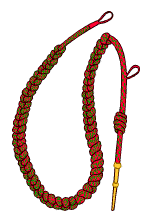
BACKGROUND:
The Belgian fourragère may be awarded by the Belgian Government if a unit was cited twice in the order of the day. Award of the fourragère is not automatic and requires a specific decree of the Belgian Government. The fourragère is the same colors as the ribbon for the Croix de Guerre. A streamer is displayed on the organizational flag/guidon to indicate award of the Croix de Guerre. The streamer is the same color and pattern as the ribbon for the medal. Army units may display the Croix de Guerre on ceremonial occasions by pinning it on the streamer. In addition, the fourragère may be displayed on the guidon for ceremonial occasions as shown in Chapter 9, Army Regulation (AR) 840-10. The Belgian Fourragère is authorized for permanent wear only. Personnel temporarily assigned to a unit which was awarded the fourragère may not wear the fourragère.
Honorable Service Lapel Button
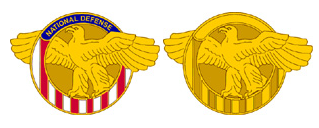
Honorable Service prior to 8 Sep 1939.
A gold color metal lapel button 7/16- inch high and 5/8-inch wide, a dexter eagle with wings displayed perched within a ring which displays seven white and six red vertical stripes with a blue chief bearing the words "National Defense," the dexter wing of the eagle behind the ring, the sinister wing in front of the ring.
Honorable Service from 8 Sep 1939 through 31 Dec 1946.
A gold color metal lapel button 7/16-inch high and 5/8-inch wide, a dexter eagle with wings displayed perched within a ring which displays thirteen vertical stripes with a chief, the dexter wing of the eagle behind the ring, the sinister wing in front of the ring.
BACKGROUND:
Lapel buttons are worn only on civilian clothing--on the left lapel for men and in a similar location for women.
The Honorable Service Lapel Button may be worn only by a person who served honorably prior to 8 Sep 1939 as an enlisted man, warrant officer, nurse, contract surgeon, veterinarian, or commissioned officer, in the Regular Army or a Citizen's Military Training Camp for 2 months, or in the National Guard, Enlisted Reserve Corps, or senior ROTC for 1 year, or in junior ROTC for 2 years.
War Department General Order No 13, dated 9 Jun 1925, authorized the wearing of the badge by individuals named and fully described by the design of the badge. It was also described in Army Regulations No 600-35, dated 31 Dec 1926, but was not illustrated in the Army Regulations until AR 600-35, dated 10 Nov 1941, was published.
In a May 1943 change to AR 600-35, the lapel button was described as being "all of blue plastic," and then in Army Regulation No. 600-35, change No. 26, dated 28 Jul 1943, a modification prescribed "all of gold plated plastic."
NOTE: The lapel button was created and produced during a period when the War Production Board had issued a restrictive order prohibiting the use of metal for such purposes. Therefore, plastic was substituted for metal and production time decreased. Originally, a blue design was specified. However, as work proceeded, it was evident that the design would not be discernable against a dark suit. Before the lapel button was issued to any individual, action was taken to gold plate all buttons. The words "National Defense" were also dropped from the description in the changes.
War Department Circulars 187 and 318, dated 19 Aug 1943 and 7 Dec 1943, respectively, provided for gratuitous issue of the button to Army personnel honorably discharged after 9 Sep 1939.
AR 600-35, dated 31 Mar 1944, lists the two lapel buttons with the different designs. In a directive dated 13 May 1944, the War Department General Staff authorized the Honorable Service Lapel Button to be manufactured in gold color metal or gold plated plastic. Change No 8, AR 600-35, 8 Aug 1946, states, "For the World War II Victory Medal, no lapel button is prescribed. (The lapel button for service rendered since 8 Sep 1939 was used in lieu of a lapel button for the World War II Victory Medal awarded to Army veterans. However, the Navy and Marine Corps authorized for wear both the Honorable Service Lapel Button and a separate lapel button corresponding to the World War II Victory Medal.)
On 24 Nov 1947, the lapel button for service rendered prior to 8 Sep 1939, was rescinded. The eligibility requirements for the Honorable Service Lapel Button are honorable federal military service between 8 Sep 1939 and 31 Dec 1946. Service beyond those dates does not qualify; in fact, a new Army lapel button, the so-called “Minute Man” was developed to recognize a minimum of nine months’ honorable active Federal service in the Army of the United States subsequent to 31 December 1946.
The Honorable Service Lapel Button has been commonly referred to as the "ruptured duck" over the years. The reason for that name and the originator of the phrase are unknown, although many claimed to have invented the nickname.
Gold Star Lapel Button – Clutch
The Gold Star Lapel Button was established by Act of Congress (Public Law 80–306) August 1, 1947, in order to provide an appropriate identification for widows, widowers, parents, and next of kin of members of the Armed Forces of the United States who lost their lives during World War I, 6 April 1917 to 3 March 1921; World War II, 8 September 1939 to 25 July 1947; any subsequent period of armed hostilities in which the United States was engaged before 1 July 1958 (United Nations action in Korea, 27 June 50 to 27 July 54); or who lost their lives after 30 June 1958, while engaged in an action against an enemy of the United States; or while engaged in military operations involving conflict with an opposing foreign force; or while serving with friendly foreign forces engaged in an armed conflict in which the United States is not a belligerent party against an opposing Armed Force; or who lost or lose their lives after March 28, 1973, as a result of an international terrorist attack against the United States or a foreign nation friendly to the United States, recognized as such an attack by the Secretary of Defense; or while serving in a military operation while serving outside the United States (including the commonwealths, territories, and possessions of the United States) as part of a peacekeeping force.
a. The Gold Star Lapel Button consists of a gold star on a purple circular background, bordered in gold and surrounded by gold laurel leaves. On the reverse is the inscription "United States of America, Act of Congress, August 1966". Gold Star Lapel Buttons inscribed August 1947 may be issued until present inventories are exhausted.
b. One Gold Star Lapel Button will be furnished without cost to the widow or widower, to each of the parents, each child, stepchild, child through adoption, brother, half brother, sister, and half-sister of a member of the Armed Forces who lost his or her life while in the active military service during the periods indicated above. The term "widow or widower" includes those who have since remarried, and the term "parents" includes mother, father, stepmother, stepfather, mother through adoption, father through adoption, and foster parents who stood in loco parentis. Request for replacement of the Gold Star Lapel Button (lost, destroyed or unserviceable) will be submitted on DD Form 3 (Application for Gold Star Lapel Button) to National Personnel Records Center, 1 Archives Drive, St Louis, MO 63138-1002.
NOTE: Per AR 600-8-22, Military Awards, paragraph 6-18, the Gold Star Lapel Button was established by Act of Congress (PL 80-306) 1 August 1947, in order to provide an appropriate identification for widows, widowers, parents, and next of kin of Service members of the Armed Forces of the U.S. who lost their lives. Previously, there were two versions of the Gold Star award issued - one with a pin catch and the other with prong-clutch or screw post. Wholesale assets of the pin catch version have been phased-out and are no longer available. The prong-clutch version will be the only Gold Star award issued with any request.
Inherent Resolve Campaign Medal (IRCM)
.png?sfvrsn=8d653f6c_0)
NOTE: The Inherent Resolve Campaign Medal (IRCM) is not yet available for issue to qualifying veterans. An issue date will be established when wholesale assets are available for procurement and stocking.
DESCRIPTION: On a bronze disc 1-1/4 inches (3.18cm) in diameter within a textural circle, a quatrefoil with an erect dagger enfiled by a scorpion held by a mailed hand and arched above and on either side of the scorpion's tail, the words “INHERENT RESOLVE” and centered below, the word “CAMPAIGN.”
On the reverse side, a single arabesque polygonal star surrounding radiating points from the center, superimposed by an eagle perched on a rectangle with wings expanded and inverted, inscribed “FOR SERVICE.''
SYMBOLISM: The scorpion, symbolic for treachery and destruction, is found on most major land masses. The dagger alludes to swiftness and determination. The eagle represents the United States and is symbolic of might and victory. The decorated star panels are common in the Arabian and Moorish styles of ornamentation.
RIBBON: The ribbon is blue, teal, sand and orange. This color combination is inspired by the colors of the Middle East landscape and the Ishtar Gate, the eighth gate leading to the historic inner city of Babylon.
CRITERIA: To qualify for the Inherent Resolve Campaign Medal, personnel must have been based in Iraq or Syria, fly missions over those countries, and/or serve in contiguous waters for 30 consecutive days or 60 nonconsecutive days. Service members who were killed or were medically evacuated from those countries due to wounds or injuries immediately qualify for the award, as do members who engaged in combat.
FOOT NOTE: It is not atypical to describe a medal design in a general concept without referencing every symbol in explicit detail. In the case of the Inherent Resolve Campaign Medal, the scorpion represents a predator arachnid that is often found in arid desert climates. The sword or dagger is a defensive weapon used to guard against and protect from dangerous elements. When combining these two symbols into the design of a military campaign medal, they represent the defense of freedom, liberty and justice from those predators who would infringe on those values considered sacred to a free and orderly society. The mailed hand clutching the dagger represents strength and courage in the defense of liberty and freedom. This armored hand is widely used in military heraldry for this purpose.
Lapel Button for Next of Kin of Deceased Personnel
Lapel Button for Next of Kin of Deceased Personnel was introduced by the Army in 1977. It is provided to the widow/widowers, parents, and primary next of kin of members of the armed services who lost their lives either while serving on active duty or while they were assigned to an Army Reserve or Army National Guard unit that was in a drill status at the time of their passing.
The button comprises a gold star within a circle (in memory of honorable service) that is surrounded by a four sprigs of oak representing the Army, Navy, Air Force, and Marine Corps. Family members who are furnished with the Next of Kin lapel button include the widow/widower, both parents, every child (including stepchildren and adopted children), brother(s) and sister(s), and half-brother(s) and half-sister(s).
In 2014, Army Chief of Staff General Ray Odierno approved the wear of both the Next of Kin and Gold Star lapel pins by Soldiers on their dress uniforms.